

How Much Do Boats Weigh? (Ultimate Data Chart)
The weight of a boat can vary a lot mostly depending on the length of the boat and the materials used for the boat. There are also many other factors such as size/amount of engines, size of the fuel tank, amount of gear on board, size of the cabin, and much more.
However, if we generalize based on length: small boats that are 17-22 feet weigh around 1,600-3,200 pounds. Boats 23-27 feet weigh around 3,600-4,800 pounds. Medium-sized boats 28-35 feet weigh around 5,800-13,500 pounds. And large boats 36-45 feet weigh around 15,500-29,000 pounds.
These calculations were found by taking many examples of boats within each boat category. However, If you want a more precise answer that considers lengths and material, continue reading to the “ Boat and trailer weight based on the type and length of a boat ” sub-heading.
It’s important to note that boats made from aluminum tend to be around 300-1,500 pounds lighter than similarly sized fiberglass boats.
Table of Contents
Knowing boat weight terms
Before getting specific with all the different boat types, knowing these terms will help you understand the data better.
If you’ve ever tried finding the weight of a boat, you’ll notice that manufacturers use a lot of different wordings. These may include dry weight, wet weight, curb weight, package weight, gross trailer weight, actual boat weight, and more.
Understanding the difference between these is important, especially if you plan on reading the rest of the article. So let’s get into it:
Dry weight is the most common weight statistic you will find on a manufacturer’s website that states the weight of their boats. It means the weight of a boat without any engines, fuel, water, or accessories. In other words, the weight of a boat straight from the factory.
Some manufacturers may include engines in dry weight, but if they do so, they will usually tell you.
Unfortunately, this number isn’t the number boat owners need; however, it’s usually the only number provided. I usually assume that the wet weight of a boat is around 300-1,500+ pounds more, mostly depending on the amount/size of the engines and the size of the fuel tank.
Wet weight/curb weight
Wet weight, also known as curb weight, is the weight of a boat including engines, accessories, fuel, oil, and any other liquids. It does not include the weight of passengers or cargo.
This is one of the most important terms you’ll need to know for your boat as it will help you find your needed vehicle towing capacity, boat lift weight capacity, and other miscellanies things.
Package weight/gross trailer weight
Package weight, also known as gross trailer weight (GTW), is the wet weight of your boat plus the weight of your trailer. This is the weight you need to know for towing.
Most trailers weigh around 600 pounds for small 17′ boats to 1,900 pounds for larger 26′ boats. Most boats over 30′ are not trailerable unless you opt for an oversized load.
Actual boat weight
Actual boat weight means the wet weight of your boat plus any equipment, people, or cargo on board your boat. If a lot of people are on board or if you have a lot of heavy fishing equipment, it will significantly raise the weight of your boat.
Factors that go into how much a boat weighs
Besides the size of a boat, there are some other factors that go into how much it will weigh including:
- Material used
- Size of engine(s)
- Amount of equipment
- Amount of batteries
- Size of the fuel tank
- Amount of fuel in the fuel tank
- Amount of water within the boat
- Amount of gear you have on-board
Most of these are accounted for in the averages I’ve provided, but if you are trying to estimate the weight of your boat and you know you have an abnormally heavy or high quantity of these things, make sure to account for it.
Boat and trailer weight based on the type and length of a boat
There are many different boat types, all of which have different weights. Below I’ve listed the weights, trailer weights, and gross trailer weights (wet weight of boat plus trailer weight) of many different boat types. Click on the boat type below to be directed to which one you want to see.
There are two popular materials used to build bass boats, fiberglass and aluminum. Fiberglass is much heavier than aluminum, so I decided to split up the two in order to give more precise averages. So:
On average, fiberglass bass boats weigh around 1,400-2,200 pounds. Aluminum bass boats weigh around 700-2,000 pounds. Their gear, fuel, and engines generally add another 400-700 pounds and their trailers generally weigh around 500-1,200 pounds.
Average fiberglass bass boat weight by length
Average aluminum bass boat weight by length.
Related Article: How Much Do Bass Boats Weigh? (17+ Examples)
On average, Bowrider boats weigh around 1,500-8,750 pounds mostly depending on their length. Their gear and fuel generally add another 500-1,600 pounds and their trailers generally weigh around 800-2,300 pounds.
On average, pontoon boats weigh between 1,600-2,400 pounds (726-1,089 kg), including the motor. However, some weigh up to 5,000 pounds (2268 kg). Pontoon boat trailers weigh between 1,000-1,700 (454-771 kg) pounds on average. Other weight factors to consider include gas, passengers, and gear.
Related Article: Pontoon Boat Weight: Can You Tow Them? (75+ Examples)
Sit-down jet skis weigh around 650-1,000 pounds, and stand-up jet skis weigh around 300-550 pounds. This includes the jet ski’s weight plus the weight for fuel and gear. Jet ski trailers weigh around 200-300 pounds, and double trailers weigh around 350-500 pounds.
Check out the weights of every new jet ski on the market in this article: How Much Do Jet Skis Weigh? (Plus Trailer Weight)
On average, ski boats weigh around 3,100 pounds. Their gear and fuel generally add another 250-600 pounds and their trailers generally weigh around 1,100-1,900 pounds.
There aren’t many true ski boats on the market anymore as they are being taken over by wake boats, however here are the weights of the top 3 on the market.
Related article: How Much Do Ski Boats Weigh? (17+ Examples)
On average, wake ski boats weigh around 4,000-6,700 pounds. Their gear and fuel generally add another 250-600 pounds, and their trailers weigh around 1100-1,900 pounds.
On average, aluminum deep V fishing boats weigh around 1,000 to 2,100 pounds. Their engines, gear, and fuel generally add another 350-700 pounds, and their trailers weigh around 500-1,100 pounds. Fiberglass equivalents generally weigh 400 more pounds.
In general, center console boats weigh between 1,100 and 8,500 pounds depending mostly on their size. Their engine, gear, and fuel add another 470 to 2,000 pounds, and their trailers weigh around 500 to 2,000 pounds.
Related Article: How Much Do Center Console Boats Weigh? (10+ Examples)
There are many different lengths and types of sailboats including both single-hull sailboats and catamarans. So their weight of them changes drastically depending on the exact make and model. However, According to Lifeofsailing.com , here are the general statistics:
On average, cuddy cabin boats weigh around 1,500-4,500 pounds mostly depending on their length. Their gear and fuel generally add another 500-800 pounds and their trailers generally weigh around 800-1,800 pounds.
Small cabin cruiser boats (30-40 feet long) weigh around 10,000-22,000 pounds. Larger ones (41-50 feet long weigh around 24,000-42,000 pounds. Their gear and fuel generally add another 1,100-4,800 pounds .
There isn’t an exact standard that defines yachts; however, in this article, I am considering them to be any recreational vessel over 50 feet long. It’s hard to find averages of boats this big as they vary a lot depending on the make/model. However, my data below is an average of three different models within each length, so it should at least give you an idea of how much a boat around that length should weigh.
On average, yachts that are 55-65 feet long weigh around 75,000-100,000 pounds, yachts 66-75 feet long weigh around 105,000-128,000 pounds, and yachts 76-90 feet long weigh around 137,000-205,000 pounds. Their gear and fuel add another 12,000-30,500 pounds.
How to weigh a boat?
The most accurate way to weigh a boat is to take it to a truck scale. Make sure it has all the gear and equipment in it that you need to have and weigh it. Also, note the amount of fuel that is in the boat as well. Gas weighs about 6 pounds per gallon, and boat fuel tanks can hold anywhere from 15 to thousands of gallons. You can then subtract out the weight of the trailer (which can be found by either weighing the trailer separately or just estimating using my averages).
Here’s what a truck scale looks like:

You can find these by just searching truck scale near me. Then try to contact them in advance or just show up at a location and they will most likely be happy to assist you if it’s within working hours.
If you’re unable to do that, most manufacturers will have the weights listed on their website; however, you may still have to do some estimating for engine, gear, & fuel weight as well as trailer weight. The data I provided above should also help you out with that.
What are the best vehicles for towing boats?
Making sure you are using a capable towing vehicle is crucial for the safety of you and others on the road when you are towing a boat. You can see a vehicle’s towing capacity by searching the make and model of the vehicle and then typing “towing capacity” after in the search bar.
It’s generally recommended to have a vehicle that is capable of towing 1,000 more pounds than the total weight of what you are towing. So in this case, the GTW would be the total weight.
Depending on how much your boat weighs, there will be different vehicles that would fit you best. However, below are a few popular vehicles used for towing boats:
Here are some popular SUVs used for towing boats
- Can tow up to 5,000 pounds.
- 2- or 4-wheel options.
- Can tow up to 7,800 pounds (V8), or 6,200 pounds (V6).
- All-wheel drive.
- Can tow up to 7,400 pounds.
- Turbodiesel option available.
- Can tow up to 8,000+ pounds depending on the model.
- Can tow up to 9,300 pounds.
- Can tow up to 8,300 pounds.
And here are some popular trucks
- Can tow up to 6,700 pounds.
- Can tow up to 7,000 pounds with the gas engine, and the diesel model adds around 700 more pounds of towing capacity.
- Can tow anywhere from 8,000 to 9,000 pounds.
- Can tow anywhere from 9,700 to 10,900 pounds.
- Recent Posts
- What Is The Cheapest Way To Store A Boat? - February 28, 2023
- Do Boats Need Bottom Paint? (Uncovering the Truth) - February 2, 2023
- How Much Is Bass Boat Insurance? (Real Quotes) - January 18, 2023
The Real Cost of Buying & Owning a 50-Foot Yacht
A 50-foot yacht can be difficult to maneuver, especially in tight spaces and harsh weather, so you need to invest in proper training for yourself and your crew. You may also need to apply for special permits and licenses to operate in certain areas. These factors can add up quickly to the overall costs, so if you are determined to own a 50-foot yacht, here's the real cost of buying and owning one.
The total estimated upfront costs of buying a 50-foot yacht range from $458,000 to $692,000 and include the initial purchase price and other fees. There are also hidden costs that total $70,000–$300,000+ per year. For ongoing costs, the total estimated annual costs are $35,000–$85,000 per year.
Although costly, with proper budgeting, maintenance, and strategic planning, you can manage the costs of owning a yacht and still enjoy the lifestyle that comes with it. Let's look at some practical tips to help you manage the costs of owning a 50-foot yacht.
- A high-end luxury yacht may cost significantly more than a basic production yacht with standard features and finishes.
- A new yacht with low engine hours and minimal wear and tear may command a higher price than an older yacht.
- Hiring a surveyor can help you save money in the long run by identifying any potential problems before you purchase the yacht.
- Fuel costs can add up quickly, since a 50-foot yacht with twin diesel engines uses almost 20–30 gallons of fuel per hour.
- Winter storage can protect your yacht from the elements, and it can also add up to the overall cost of owning a yacht.
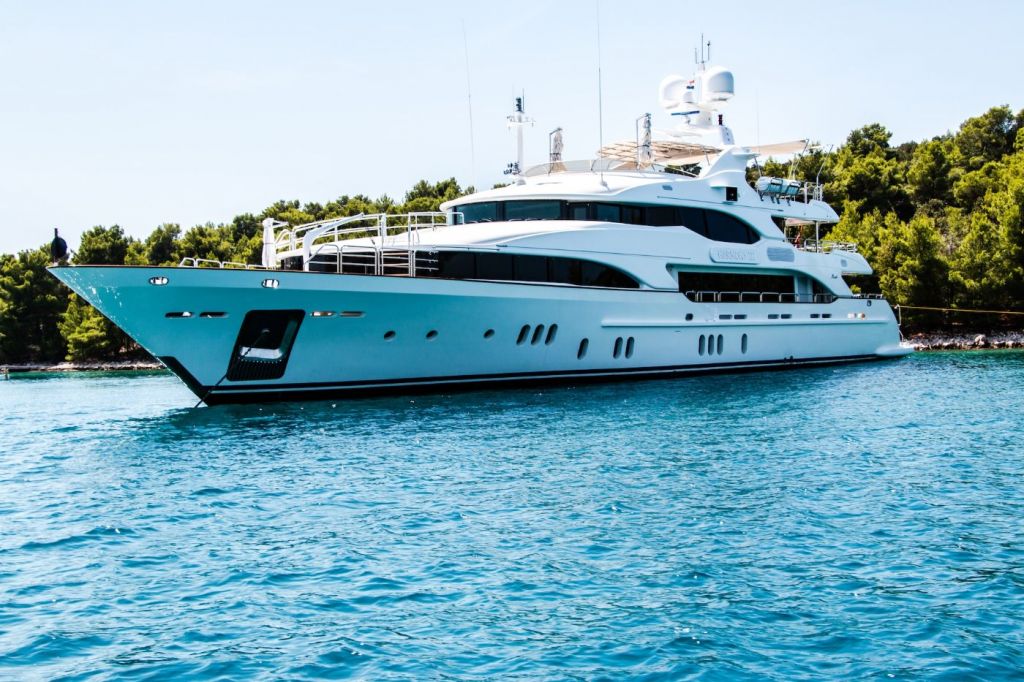
On this page:
Cost of buying & owning a 50-foot yacht, upfront costs of buying a 50-foot yacht, hidden costs of owning a 50-foot yacht, ongoing costs of owning a 50-foot yacht, tips for managing the costs of owning a 50-foot yacht.
When buying a 50-foot yacht, there are several costs to consider, such as upfront costs, hidden costs, and ongoing costs per year. Here's a rundown on the all-in cost:
In this section, we will break down these costs into sub-sections to give you a better idea of what you can expect.
The purchase price of a 50-foot yacht varies depending on the model
Different models of yachts may have different features, amenities, and capabilities, which can affect their value and appeal to buyers . A high-end luxury yacht with state-of-the-art technology, custom finishes, and top-of-the-line appliances may cost significantly more than a basic production yacht with standard features and finishes.
Similarly, a newer yacht with low engine hours and minimal wear and tear may command a higher price than an older yacht with more use and maintenance requirements. Yachts located in popular boating destinations or areas with high demand may be priced higher than those in less desirable locations.
Here are some examples of different yacht models, their amenities, and estimated prices:
Sales tax and registration fees
When you purchase a yacht, you will need to pay sales tax and registration fees. In some states, you may be able to avoid paying sales tax if you purchase the yacht in a different state and keep it there.
In Florida, the sales tax rate is 6% , but there is a cap of $18,000 on the amount of tax you will pay. So if you purchase a yacht for $500,000, you will only pay $18,000 in sales tax.
On the other hand, registration fees are the fees you need to pay to register your yacht with the state where you plan to operate it. The fees are typically used to fund marine programs, such as boating safety education, law enforcement, and conservation efforts.

Some states charge a flat fee, while others charge based on the length of the yacht. In some cases, the registration fees may also be based on the age or value of the yacht. These fees are typically renewed annually, and failure to renew your registration can result in penalties or fines.
Registration fees in Florida for a yacht over 110 feet in length can be as high as $4,000 per year. However, for a yacht under 16 feet in length, the registration fee is only $5 per year.
Survey and inspection costs
A survey and inspection is essentially a thorough examination of the yacht by a professional surveyor. The surveyor will inspect the vessel from top to bottom, looking for any issues or potential problems that could affect the yacht's seaworthiness or value. This includes checking the hull, deck, rigging, electrical systems, plumbing, and more.
For smaller yachts, the cost may be a few hundred dollars, while larger and more complex yachts could cost several thousand dollars.
By identifying any potential problems before you purchase the yacht, you can negotiate with the seller or even decide not to purchase the yacht altogether. In the long run, this can save you money and help ensure that you're making a sound investment.
Insurance and financing costs
Insurance rates can vary widely, but you can expect to pay a premium for coverage. The higher the value of the yacht, the higher the insurance premium will be.
As for financing, the interest rates for yacht loans are typically higher than those for home or car loans. This is because yachts are considered luxury items and are often seen as a higher-risk investment. The interest rate you'll be offered will depend on your credit score, income, and the amount of the loan you're seeking.

Aside from the upfront costs, there are also hidden costs beyond the initial purchase price. Here are some hidden costs you should be aware of:
Environmental and regulatory compliance
Owning a yacht also comes with environmental and regulatory compliance costs. You may need to pay for permits to dock your yacht in certain areas, or you may need to invest in equipment to comply with environmental regulations. These costs can add up quickly and may not be immediately apparent when you're considering purchasing a yacht.
Crew and staffing costs
If you plan to use your yacht frequently, you'll likely need to hire a crew to help you maintain and operate it. Crew and staffing costs can include salaries, benefits, and insurance, and can be a significant expense over time. Additionally, you may need to pay for crew training and certification , which can add to the overall cost of owning a yacht.
If you're looking for paid courses for your crew, here are 9 best sailing courses you might want to check out.
Costs of upgrades and customizations
While a 50-foot yacht may come equipped with many standard features, you may want to add additional amenities or customize the interior to your liking. These upgrades can be expensive and may not be covered by your initial purchase price.
Upgrades and customizations can range from relatively minor changes such as adding a new sound system or upgrading the navigation equipment, to more extensive modifications such as adding a new deck or completely redesigning the interior of the yacht. The cost of these upgrades will be based on the extent of the modifications and the materials and labor involved.
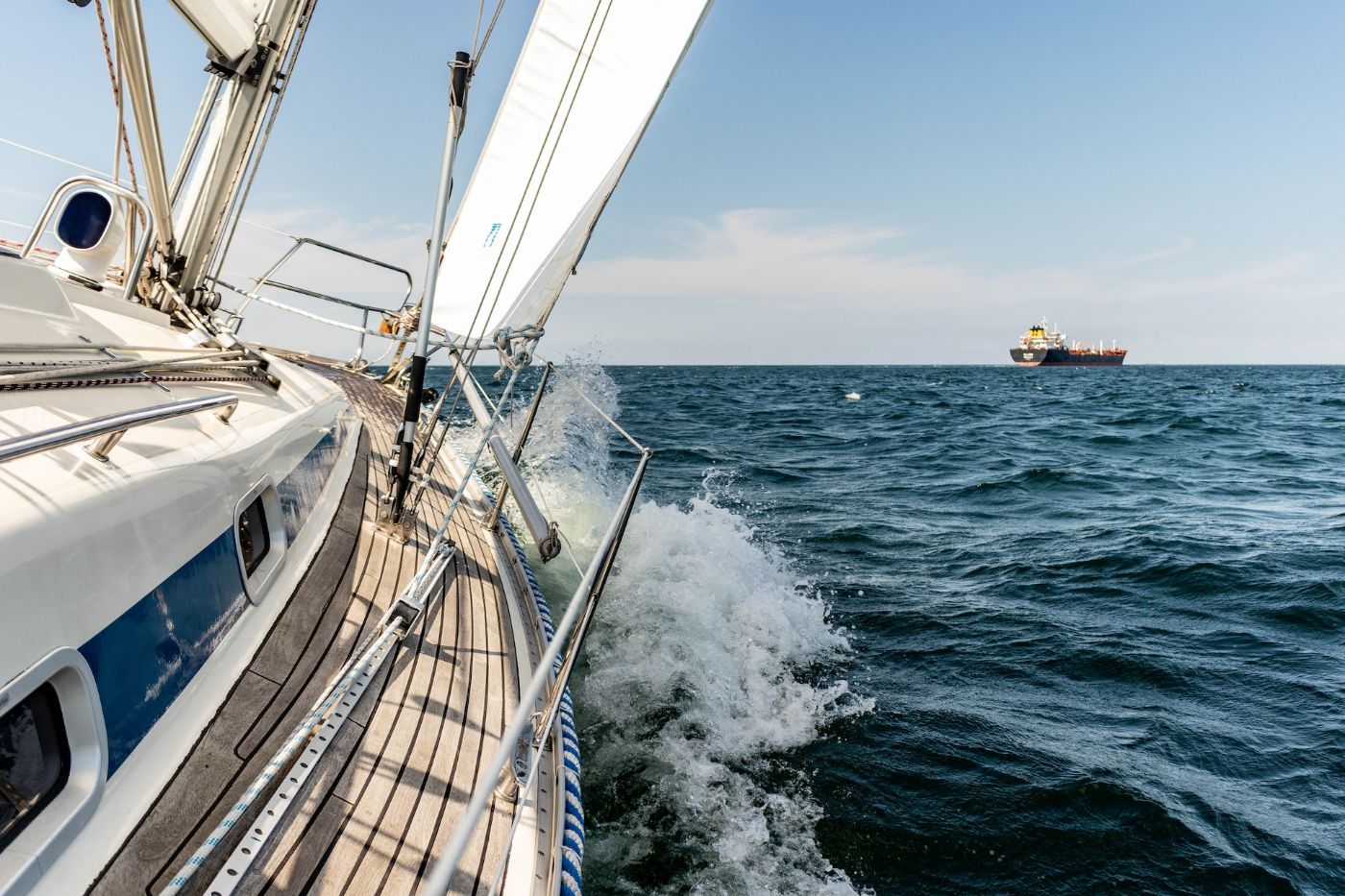
In this section, we will discuss the ongoing costs of owning a 50-foot yacht.
Maintenance and repair costs
Regular maintenance helps keep your yacht in good condition and prevents costly repairs. Some common maintenance and repair costs include:
- Engine maintenance
- Hull cleaning and painting
- Electrical and plumbing repairs
- Sail and rigging repairs: ( Here's an article on the cost of replacing a standing rigging )
- Interior and exterior cleaning
Docking and storage fees
Some common docking and storage fees include:
- Monthly slip rental fees: These fees cover the cost of renting a slip at a marina or dock for your yacht to be moored. Slip rental fees can range from a few hundred to several thousand dollars per month.
- Winter storage fees: During the off-season, many yacht owners choose to store their vessels on land to protect them from the elements. The cost of winter storage can range from a few hundred to several thousand dollars per season.
- Launch and haul-out fees: These fees cover the cost of launching your yacht into the water and hauling it out for maintenance or storage, and vary based on the location and the size of your yacht.
- Electricity and water fees: Many marinas charge additional fees for the use of electricity and water while your yacht is in the slip.
Fuel and operating costs
A 50-foot yacht typically has twin engines, which can be either gasoline or diesel. Diesel engines are generally more fuel-efficient and have a longer lifespan than gasoline engines, but they are also more expensive to purchase and maintain.
On average, a 50-foot yacht with twin diesel engines will use about 20-30 gallons of fuel per hour, while a gasoline-powered yacht will use about 40-50 gallons per hour.
Routine maintenance such as oil changes, filter replacements, and hull cleaning is part of the overall operating costs and will cost several thousand dollars per year. More significant repairs or upgrades, such as engine overhauls or electronics replacements, can cost tens of thousands of dollars.
Costs for insurance and maintenance reserves
Insurance can protect you from liability and damage to your yacht, while maintenance reserves can help cover unexpected repairs. Some common insurance and maintenance reserve costs include:
- Liability insurance
- Hull and machinery insurance
- Personal property insurance
- Emergency repairs and reserves
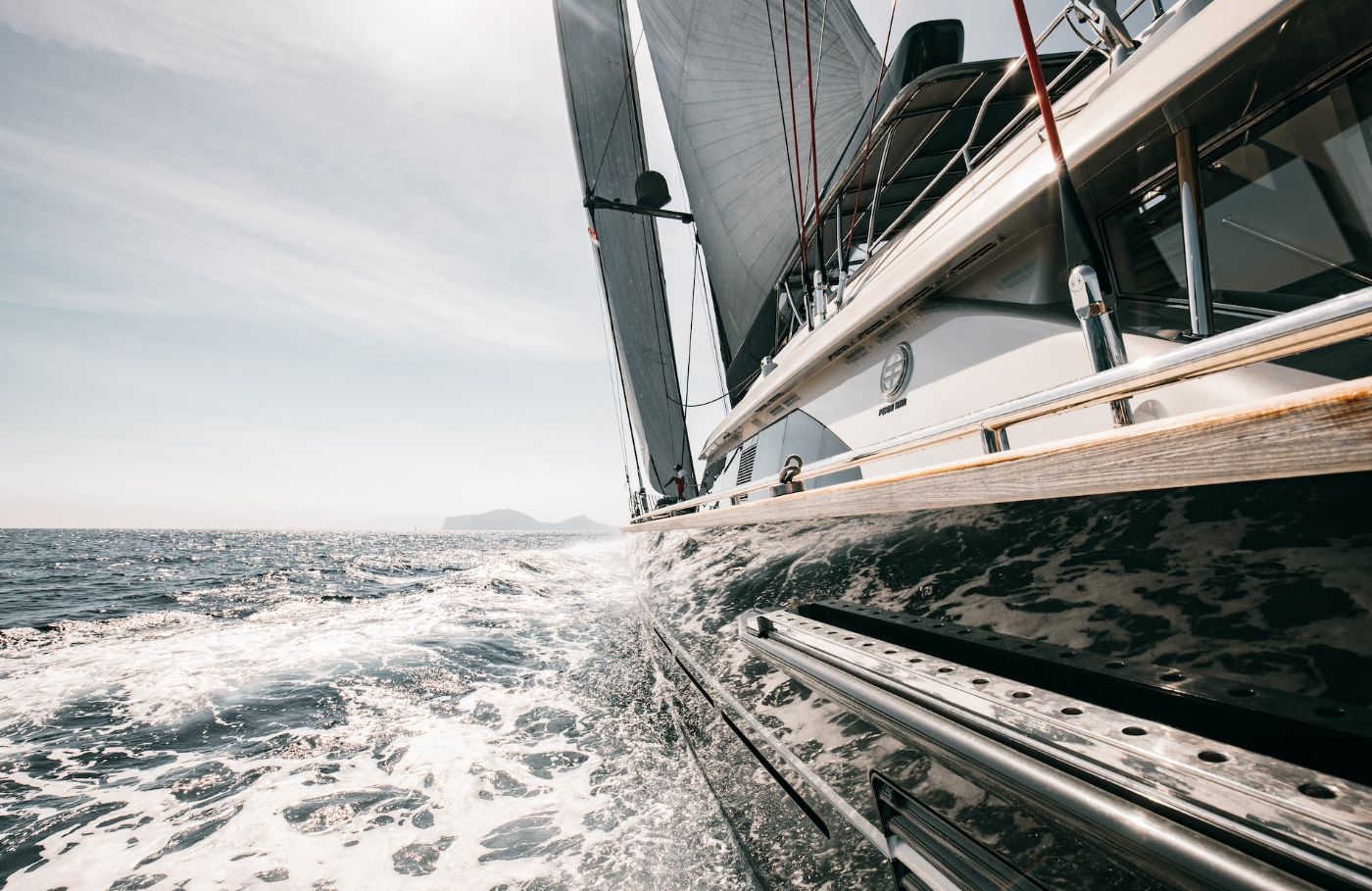
Here are some tips to help you manage the costs of owning a 50-foot yacht:
Create a budget and stick to it
Your budget should include all of the costs associated with owning and maintaining your yacht, including mooring fees, insurance, fuel, maintenance, and repairs. Try to plan for unexpected costs, such as emergency repairs or unexpected upgrades.
You should also plan ahead for seasonal expenses, such as winterizing your yacht when the boating season is over . By creating a budget and planning ahead, you can avoid surprises and ensure that you have the funds necessary to keep your yacht in top condition.
Do the basic maintenance and repairs by yourself
While there are some tasks that require a professional, such as engine repairs or electrical work, there are many things you can do yourself with a little knowledge and the right tools.
By doing your own maintenance and repairs, you can save money on labor costs and ensure that your yacht is always in top condition. You can also take pride in knowing that you are taking care of your investment and keeping it in great shape.
Consider sharing and chartering options
If you don't use your yacht all the time, you may want to consider sharing or chartering options as a way to offset the costs of ownership. Sharing your yacht with friends or family members can help split the costs of maintenance and repairs while chartering your yacht to others can help generate income.
There are many websites and companies that specialize in yacht sharing and chartering where you can find an option that works best for you. Just be sure to carefully vet anyone who will be using your yacht to ensure that they are responsible and will take good care of your investment.
Learn some selling and trading strategies
If you find that the costs of owning a 50-foot yacht are too high or you are ready to move on to something else, you may want to consider selling or trading your yacht. There are many strategies you can use to get the best price for your yacht, including working with a broker, advertising online, or attending boat shows.
If you are interested in trading your yacht for something else, perhaps carefully consider your options and work with a reputable dealer. By using these strategies, you can ensure that you get the best value for your investment and can move on to your next adventure with confidence.
Leave a comment
You may also like, cost of buying & owning a small yacht (detailed breakdown).
While some people may prioritize a slower, more eco-friendly, and more hands-on experience that they get from a sailing yacht, others may prefer a faster, more …

The Average Cost of Owning a Boat in Florida (4 Examples)

Average Cost of Buying & Owning a Catamaran (With 4 Examples)
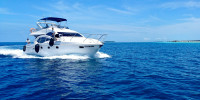
2023 Cost Of Mediterranean Yacht (As Seen On Below Deck)

Average Cost of Buying & Owning a Yacht in Dubai (2023)
Own your first boat within a year on any budget.
A sailboat doesn't have to be expensive if you know what you're doing. If you want to learn how to make your sailing dream reality within a year, leave your email and I'll send you free updates . I don't like spam - I will only send helpful content.
Ready to Own Your First Boat?
Just tell us the best email address to send your tips to:

About Kraken
Find out more about Kraken Yachts. Check out the latest Kraken in-build at our bespoke factory in Turkey or meet the team behind the yachts.
Kraken Design
Kraken Yachts are the safest blue water sailing yachts in build today. Find out what makes our yachts so special.
Kraken News
Stay up-to-date with everything Kraken Yachts. See our reviews in yachting magazines from around the world or find out about Kraken Yachts and all things sailing in Ocean Sailor Magazine.

Get more from Kraken Yachts . Watch, listen and read everything about bluewater sailing.

Kraken Yachts
In development.

The Kraken 50 is designed to be the ultimate short-handed blue water cruising yacht.

raising the standards
Exceptional equipment list included in the kraken standard specification.
- 7 kw Onan generator
- 180 lt per hour Hydro Master water maker
- Full Solent dual headsail rig with full suite of Quantum sails
- Emergency high output bilge pump (in addition to standard bilge pumps)
- Triple tank Racor fuel polishing and transfer system
- Harken electric primary and secondary winches
- GN Espace Delux Range, with induction hob and electric oven
- 2.7 m inflatable dinghy with 4 hp Yamaha outboard
- Full reverse cycle Webasto Air Conditioning to all cabins
- Side Power 100 KGF bow thruster
- Garmin dual station electronics, 2x Garmin 9" GPS plotters, 2x Garmin VHF radios, Garmin wind, speed, depth sounder and Garmin autopilot
- Kraken permanent, rigid, soft-top bimini, with fixed plexiglass and stainless steel windscreen, complete with removable screens forward and side
- Viking valise life raft - 6 man
- Solas offshore flare pack
For price, delivery dates & options, enquire now:
Design specification.
- Length Overall 50 ft
- Waterline Length 44.86 ft
- Beam Overall 14.76 ft
- Beam Waterline 12.47 ft
- Draft 7.54 ft
- Air Draft 81.35 ft
- Displacement 41,888 lbs
- Ballast Weight 14,330 lbs
- Ballast Ratio 34.2%
- Sail Area 1444.52 sq.ft
- Sail Area Displacement Ratio 19.2
- Engine Power 80 HP
- Fuel Tanks (3 tanks) 223 us gal
- Water Tanks (2 tanks) 148 us gal
- CE Certification RCD Category 'A' Ocean
- Length Overall 15.24 m
- Waterline Length 13.68 m
- Beam Overall 4.50 m
- Beam Waterline 3.80 m
- Draft 2.30 m
- Air Draft 24.80 m
- Displacement 19,000 kg
- Ballast Weight 6,500 kg
- Sail Area 134.2 sq.m
- Engine Power 59 kW
- Fuel Tank 845 L
- Fresh Water Tanks 560 L
For a full, detailed specification of the Kraken 50:
Build specification.
- One piece hull and integral ZERO keel
- ALPHA™ Rudder System
- Solid crash zone at bow waterline
- Structural frames and stringers
- Deck Structure
- Integral Kraken moulded safety bulwark
- Saloon/coach roof windows
- Hull finishes
- Build standard and certification
All Kraken's comprise of a one piece hull and integral Zero Keel which houses a sealed lead ballast bulb.
The hull lay up is built using 17-22 layers of composite engineered fabrics bonded together by vinyl-ester resins.
The general hull thickness is a minimum of 15mm.
Aramid fibre composites (Kevlar) is also used in all impact areas, the bow stem, the front of the keel and the keel base.
The hull topsides incorporate 25mm closed cell foam, the FRP foam sandwich which extends from 40cm (16") above the waterline to deck level. This structure improves insulation and overall hull form rigidity.
A Kraken's hull and structures exhibited no flexing.
Click here to learn more about the ZERO Keel

The rudder and steering system is the most vulnerable element of any yacht, in recognition of this, the Kraken engineering and design team have developed the world's safest rudder and steering system.
The rudder is fully protected and supported by a full length skeg with an integral stainless steel beam, which has at its foot the first rudder bearing. The 3 ¾" (82mm) rudder stock has a second (main) bearing at its centre as it passes into the hull at the transom. This bearing is accessible and removable from the inside of transom. Even at sea!
The rudder stock has a removable third bearing at the top inside the stern lazarette. The rudder itself, comprises an integral stainless steel armature, which is welded to the stainless steel rudder stock. It is then finished and faired using FRP/vinyl-ester.
Learn more about the ALPHA™ Rudder here
A heavily reinforced ‘solid crash zone’ below the anchor chain locker, incorporating high density closed cell foam with substantial reinforcements in aramid fibres extends from above the waterline to 40cm below it. This solid area runs through to the first sealed bulkhead providing maximum collision protection.
https://krakenyachts.com/wp-content/uploads/2023/02/Kraken-Structure-Animation.mp4
All longitudinal and latitudinal structures are individually bonded in during the hull layup stages with no prefabricated structural components . The video below explains how the structural frames and stringers work on a Kraken Yacht.
All bulkheads are vacuum infused FRP with 25mm structural foam core. No plywood is used. There are two watertight sealed bulkheads forward, one between the anchor locker and the forward lazarette and a second one between the forward lazarette and the interior. A further watertight, sealed bulkhead at the stern divides the interior from the aft lazarette.
The structural bulkheads are fully bonded into the hull stringers & frames.
The deck is vacuum infused FRP using composite fibres and vinyl-ester resin with a structural foam core. This provides high levels of rigidity and insulation.
The deck structure is single-skin FRP around the base of all deck fittings.
The outside finish of the deck is panelled non-slip gelcoat with Flexiteek side decks and cockpit sole as standard.

All Kraken have an Integral moulded safety bulwark with concave internal surface for superior deck safety at sea.

Ultra-high impact-resistant laminated glass is used in the wrap-around saloon windows and port lights so that accidental damage will not result in water ingress to the interior.

Standard hull gelcoat colour is Signal White. Many colour options available at owners choice.
Double line boot top in Alwgrip to owners colour choice.
3 x coats of primer and sealer applied below the waterline before standard antifoul in dark grey, other colour choices available.

All Kraken's are designed and built to exceed ISO CE RCD Category ‘A’ - or to ABYC standard or other local area equivalent at owners request.

All Kraken’s comprise of a one piece hull and integral Zero Keel which houses a sealed lead ballast bulb.
The hull topsides incorporate 25mm closed cell foam, the FRP foam sandwich which extends from 40cm (16″) above the waterline to deck level. This structure improves insulation and overall hull form rigidity.
A Kraken’s hull and structures exhibited no flexing.
The rudder and steering system is the most vulnerable element of any yacht, in recognition of this, the Kraken engineering and design team have developed the world’s safest rudder and steering system.
The rudder is fully protected and supported by a full length skeg with an integral stainless steel beam, which has at its foot the first rudder bearing. The 3 ¾” (82mm) rudder stock has a second (main) bearing at its centre as it passes into the hull at the transom. This bearing is accessible and removable from the inside of transom. Even at sea!
A heavily reinforced ‘solid crash zone’ below the anchor chain locker, incorporating high density closed cell foam with substantial reinforcements in aramid fibres extends from above the waterline to 40cm below it. This solid area runs through to the first sealed bulkhead providing maximum collision protection. Click here for illustration
All longitudinal and latitudinal structures are individually bonded in during the hull layup stages with no prefabricated structural components . Click here for illustration.
The deck structure is single skin FRP around the base of all deck fittings.
The outside finish of the deck is panelled non slip gelcoat with Flexiteek side decks and cockpit sole as standard.
All Kraken’s have an Integral moulded safety bulwark with concave internal surface for superior deck safety at sea.
Ultra-high impact resistant laminated glass is used in the wrap around saloon windows and port lights, so that accidental damage will not result in water ingress to the interior.
All Kraken’s are designed and built to exceed ISO CE RCD Category ‘A’ – or to ABYC standard or other local area equivalent at owners request.
Key Features

The Zero Keel™
Zero bolts, zero risk. Each Kraken yacht includes our fully integral ZERO™ Keel to protect against floating debris and grounding.
The Alpha Rudder™
Each yacht includes the ALPHA™ Rudder System, incorporating a full-length skeg-hung rudder and in-water removable rudder bearings.
Build Structure
All Kraken yachts are built with a substantial interior structure to ensure keel delamination and failure cannot occur.
Build Your Kraken

Explore The Kraken 50
The exterior.

The Interior

Enquire Now
Enquire below for prices, delivery dates, options and upgrades
© All rights reserved Kraken Yachts 2024
Designed & created by Oncrowd

Full Specifications
The Kraken 50 is the perfect blue water cruiser for short-handed crews. She also accommodates up to eight crew in comfort, according to the layout chosen. As with all Kraken yachts, the Kraken 50 is built with a very robust construction process and design features specifically tailored to enable her crew to explore the world. The K50 is built with the integral ZERO™ Keel and the ALPHA™ Rudder System which incorporates a full length skeg which protects the rudder from collision damage from floating debris or grounding. The Kraken 50 hull layup comprises 17-22 layers of composite fibres including aramid (Kevlar) engineered fabric,
laminated in a vinyl ester resin system. It’s 18mm construction provides far greater impact resistance and enjoys more integral strength than any other GRP or Aluminium yacht in production today. All Kraken yachts feature the versatile Solent dual headsail rig as standard. The specification of the rigging is deliberately overbuilt to withstand the rigours of ocean sailing. Please note: The Kraken 50’s standard specification is full sail-away and many items of equipment that are normally found as upgrades or options are already included.
- Displacement (Light ship) 41,888 lb
- Displacement (Full Load) 50,706 lb
- Ballast Weight 14,330 lb
- Ballast Ratio 35.60%
- Main Sail Area 886.39 sq.ft
- Genoa (140%) Sail Area 796.53 sq.ft
- Jib (100%) Sail Area 546.53 sq.m
- Engine Power 80 hp
- Fuel Tanks (aluminium x3) 223 gallons
- Fresh Water Tanks (s-steel x2) 148 gallons
- Black Water Tanks (GRP x 2) 48 gallons
- Grey Water Tanks (GRP) 79 gallons
- Displacement (Light ship) 18,250 kg
- Displacement (Full Load) 23,000 kg
- Main Sail Area 82.35 sq.m
- Genoa (140%) Sail Area 74 sq.m
- Jib (100%) Sail Area 50.77 sq.m
- Fuel Tanks (aluminium x3) 845 L
- Fresh Water Tanks (s-steel x2) 560 L
- Black Water Tanks (GRP x 2) 180 L
- Grey Water Tanks (GRP) 300 L
• One piece hull and keel, featuring the unique Zero Keel with internal lead ballast. Solid fiberglass hull of a general layup thickness of 18mm below the waterline extending 40cm above. Stiffness, rigidity and strength as well as excellent thermal insulation is achieved by the foam cored topsides.
• The hull layup comprises 17-22 layers of FRP composites with engineered fabrics including aramid fibres.
• Kevlar™ reinforcements in impact area of forebody and leading edge of ZERO™ Keel.
• Heavily reinforced ‘crash zone’ below anchor chain locker incorporating high density foam, Kevlar™ and substantial reinforcements and extending above the waterline by 40cm.
• Structural components are individually bonded during the hull layup stages with no prefabricated structural components used.
• Vacuum bonded foam cored deck and superstructure with high density inserts and single layer GRP laminates in load bearing regions. Deck hardware is mounted to areas of extra reinforcement and strength.
• Sealed waterproof bulkheads protect the bow and transom area forward and aft.
• All bulkheads are foam cored and FRP laminated for maximum strength and rigidity.
• Integral Kraken moulded safety bulwark with concave internal surface for superior deck safety at sea.
• ALPHA™ Rudder System with full length skeg supported rudder. Integral stainless steel bonded reinforcing armature from hull to lower skeg with stainless steel shoe. This provides additional impact resistance and strength to the steering system. This unique system also allows the main rudder bearing to be maintained or repaired in water.
• GRP moulded deck with Flexiteek™ synthetic teak decking to cockpit sole and side decking. Non-slip gel coat fore and aft coachroofs.
• Ultra-high impact resistant glass in wrap around saloon windows. Port lights in the hull.
• Standard hull gelcoat colour Signal White. Many colour options available, owners choice.
• 3 x coats of primer and sealer applied below the waterline before standard antifoul in dark grey – other colours available upon request.
• Designed and built to meet and exceed RCD Category ‘A’ – Ocean, ABYC or local area equivalent at client request.
Deck Equipment
• Seldén anodized aluminium 2x spreader furling mast.
• Seldén electric in-mast furling.
• Seldén anodized aluminium boom with ball bearing outhaul car.
• Seldén mechanical rigid vang.
• Dual headsail Solent rig for easy handling and performance at all points of sail. The ultimate blue water cruising rig with coachroof mounted tracks for jib cars for upwind sailing.
• Two Furlex manual foresail furlers with lead blocks to cockpit and rope clutches for control of furling lines from the safety of the cockpit. • 10-14mm 1×19 Dyform stainless steel wire standing rigging.
• Mast mounted halyard racks for foresail halyards – to reduce rope quantity and deck loads and to utilise cockpit winches for halyard controls for safe and easy sail handling.
• All halyards are Dyneema, all sheets, furling lines and other utility lines are multicored sheaved polyester.
• All halyards run below deck in channels, eliminating tripping hazards.
• Quantum Sails™ Dacron crosscut mainsail.
• Quantum Sails™ Dacron crosscut upwind furling jib with UV strips.
• Quantum Sails™ Dacron crosscut 140% reaching genoa with UV strip.
• High-level stainless-steel stanchions & triple lifelines on top of bulwark for clear decks, reduced tripping hazards and ease of cleaning. Stanchion bases incorporate strong points for securing barber haulers or downhauls or for safety harness attachment.
• Padeyes mounted to deck for attachment of jacklines x 6.
• Stainless steel pushpit.
• Side deck boarding gates port and starboard with incorporated boarding ladder to ease boarding and to avoid the need to climb over lifelines when coming alongside.
• Split pulpit on bow for ease of access to bow area during anchoring and flying sail use.
• Stainless steel grab rails mounted to coachroof for safe foredeck access.
• Kraken Stainless-steel heavy-duty cleats mounted to stainless base plate with bulwark fairleads x 6 – (2 x fore, 2 x midships, 2 x aft).
• Harken Radial 60ST self-tailing primary winches x 2 – Electric.
• Harken Radial 60ST self-tailing secondary/utility winches x 2 – for halyards, jib sheets and reefing –Electric.
• Harken Radial 50ST self-tailing mainsheet and traveller winches x 2 – Manual.
• Spinlock rope clutches and deck organiser for the topping lift and halyard controls.
• Harken mainsheet traveller and car with 2:1 purchase. Dual mainsheet controls, port and starboard.
• Fore deck sail locker / lazarette with watertight bulkhead to chain locker and second structural bulkhead to interior. Fitted with lockable latch hardware.
• Lewmar opening flush deck hatches. (Number subject to layout)
• Foredeck seawater and freshwater wash down pump and deck connector.
• Dual roller, heavy duty bow roller system incorporating mounting for optional bow sprit for the use of asymmetric spinnaker, furling code k or other flying sail option.
• Lewmar V5 24VDC electric anchor windlass with chain and rode compatible gypsy. Deck mounted foot switches and pedestal controls included.
• Deck access chain locker to assist with the recovery of chain during anchoring operations.
• Unique Kraken chain locker design to reduce the build up of chain during anchor recovery and to improve drainage of the chain locker.
• Lewmar Delta 40kg anchor. 100m of 12mm chain + 40m of octoplait.
• Kraken solid plexiglass / stainless steel wind screen.
• Soft top, tubular stainless steel bimini with Ferrari Stamoid top. Includes removable forward and side panels and fitted bimini lights.
• Bespoke Kraken steering pedestal and console.
• Plastimo Horizon 135 compass mounted to pedestal.
• Raised helm floor to enable uninterrupted visibility forward.
• Moulded foot braces port and starboard at the helm position for bracing whilst under sail on either tack.
• Stainless steel helm wheel, Jefa Steering 1200 mm.
• Jefa Steering torque tube system with integrated autopilot drive.
• Emergency tiller with deck access to rudder stock.
• Teak cockpit table with stainless steel grabrail, foot brace support, cupholders and storage lockers. Oiled finish
• Ergonomic layout of sail controls to allow operation of sail controls by shorthanded crews.
• Plexiglass sliding companionway hatch.
• A unique Kraken vertical sliding plexiglass storm board with adjustable height control system. This replaces multiple storm boards that are a danger to the crew and the yacht.
• Opening portlights to cockpit well x 4 – galley, master cabin, shower and engine room.
• Cockpit cushions in Textilene with fast drain foam interior. Fast mount attachments.
• Three hatches to large aft lazarette locker and one dedicated life raft locker. All with lockable latches.
• Dedicated emergency steering tiller & grab bag locker.
• Fold out swim platform.
• Transom steps.
• Stainless steel pushpit gate to swim platform.
• Diving / swim ladder with oval steps to ease re-boarding from the water.
• Aft deck seawater and freshwater wash down pump and deck connector.
Engine & Propulsion
• Yanmar™, 80HP – 4JH80 – Common-rail diesel engine supported by flexible mounts.
• Side Power 24V tunnel bow thruster with dedicated battery (175Ah 24VDC) and charger.
• Stainless steel propeller shaft 1.5” (F51 Duplex) supported by custom ‘V’ bracket and dripless shaft seal.
• Bruntons Sigmadrive™ flexible coupling for isolation of vibration from engine to hull.
• Bruntons Autoprop™ self-pitching propeller.
• Engine start panel and tachometer mounted in cockpit.
• Single lever engine control on steering pedestal.
• 125A@12VDC alternator.
• Vetus PVC engine cooling water strainer with removable filter.
• Engine space and machinery room isolated with vibration dampening plate and 40mm (1.5”) acoustic insulation and protected with painted aluminium liner. High specification fire retardant materials and acoustic insulation for quiet running under power.
• Kraken triple fuel tank and polishing system provides essential fuel system maintenance and engine reliability. The system incorporates a single cup primary filter and dual cup dedicated engine filter, installed within machinery room for ease of access and maintenance. The use of a running tank to store clean fuel combined with the fuel filters ensures only clean fuel is delivered to the engine or generator. Cleaning of fuel can be undertaken from any tank to any other tank and this will remove contaminants from the fuel to ensure reliable service of the engine no matter the quality of the fuel delivered to the storage tanks.
• Kraken designed recessed eco deck fuel filling station ensures no contamination can occur through deck fillers and any spillages are retained within the fuel filling locker.
Navigation & Communications
• Garmin™ Wind, Speed and Depth transducers.
• Garmin™ GPSMAP 923xsv 9″ Chartplotter at the navigation station.
• Garmin™ GPSMAP 923xsv 9″ Chartplotter at the helm.
• Garmin™ VHF 115 handset and speakers at chart table.
• Garmin™ Reactor™ 40 autopilot with autopilot GHC™ 20 at the helm.
Electrical Systems
• Cummins Onan 7kW generator including sound shield for quiet operation.
• AGM House Batteries 720Ah at 24V. (6x 240Ah@12V)
• AGM Engine and generator start batteries x 2, 12v, 110Ah.
• AGM Bow thruster / windlass battery 24v, 240Ah.
• Heavy duty battery change over and twinning switch.
• 12V/24V electrical distribution panel – Remote battery isolator switches.
• Victron Quattro 8000VA Charger / Inverter.
• Victron 24VDC to 12VDC converter for navigation electronics.
• LED ceiling lights, reading lights and hanging locker lights.
• LED Chart table light (red / white).
• LED spreader lights, downward pointing on lower spreader.
• Aqua Series 4 LED Navigation lights – deck level port, starboard and stern lights.
• 24VDC machinery space / Engine room blower.
• Electric bilge pumps x 4, Bilge pump float switches and alarm panel and manual override.
• Additional very high volume bilge pump (14,000 l/h) for emergency flooding control inclusive of high level sensor and alarm.
• 15m Shore power cable.
• Shore power sockets, stainless steel x 2 in both forward and aft lazarettes.
• 110V or 220V electrical distribution panel – Owners choice.
• AC multi standard sockets with USB charger in cabins, at chart table, saloon and galley. (Quantity and position is layout dependent)
• Shore power galvanic isolator for reduced galvanic corrosion whilst connected to shore power supply.
• Pressurised hot and cold water system.
• Electric sump pumps in all showers.
• Main engine / 220VAC dual element hot water calorifier 42 litres.
• All heads include holding tanks with gravity discharge and deck pump out fittings.
• Separate grey water tank for each head with electric pump discharge deck pump out fitting
• Interior joinery in white oak, afromosia or cherry using selected timbers and decorative veneers.
• Cabin sole in oak, walnut or afromosia.
• Concealed hinges and quality latches on locker doors and solid timber doors frames.
• High quality marine fabrics for cushions and headboards. • Lee cloths or folding lee boards per berth.
• Removable vinyl head lining panels using Fastmount™.
• Smoke detectors throughout. Carbon monoxide detector in engine room. (number of smoke detectors dependent on layout selected).
• Raise full view self contained navigation/ pilot station with chart table and instrument consol. This enables the crew to carry out watches in the warmth of the saloon.
• Secure and comfortable navigation chair incorporating grab rail and side support.
• Webasto Full tropical air-conditioning system with reverse air cycle heating.
• Fully gimballed, GN Espace OceanChef 3 Induction Cooker. See website for details.
• Stainless grab rail / safety rail to protect accidental contact with cooker.
• Built in Vitrifrigo stainless steel 24VDC double drawer style fridge 144L – supplied with keel cooler for efficient cooling in all climates. See website for details.
• Built in Vitrifrigo stainless steel 24VDC single drawer style freezer 75L – supplied with keel cooler for efficient cooling in all climates. See website for details.
• Hydromaster 180l/h Watermaker. • Kraken dual purpose bins. Two garbage bins alongside each other to enable the disposal of biodegradable waste overboard as well as deep bin for non biodegradable shore side disposal of non-bio degradable waste.
• Blanco single stainless steel sink with chopping board cover in Galley.
• HI MACS™ Alpine White (natural acrylic stone) sinks in heads.
• Solid stainless steel taps and bathroom fittings throughout.
• Plexiglass bifold doors to all showers.
• HI MACS™ (natural acrylic stone) worktops and head surfaces with moulded fiddle rail to make cleaning and maintenance of surfaces easy.
• Vetus electric toilets, sea water flushing.
• 4x fire extinguishers throughout and 1x fire-blanket in the galley.
• Solid timber and real wood veneer saloon table with fixed pedestal. Large amounts of storage space throughout.
• Large access panels to bilges, fuel and water tanks with large access hatches in all tanks.
• Solid laminated timber / stainless steel tubular companionway. Steps with angled ends allow safe use at sea.
• Access panel beneath companionway steps with removable panel to engine for improved access for servicing. Acoustic and thermal insulation for quiet accommodation spaces.
• Overhead hatches and ventilation throughout.
• Raised deck saloon provides excellent all round visibility through high specification impact resistant laminated glass.
• Dedicated wet locker with warm air supply close to companionway for the storage of wet-weather gear and lifejackets.
• Headboards in selected high-quality fabrics.
• Hinged lifting access on gas struts to storage beneath of master cabin double berth.
• Large capacity drawers under each berth.
Safety Equipment
• Fire extinguishers x6. (subject to layout)
• Horseshoe life ring and beacon.
• Fire blanket.
• Manual bilge pump in cockpit.
• Automatic engine room fire suppression system with manual override.
Ancillary Items
• 2.7m roll up hypalon dinghey.
• 4HP Yamaha outboard.
• 6 x F7 fenders.
• Boathook.
• 6 man life raft.
• Hand flares x2, parachute flares x2 and buoyant smoke x1.
• 4 x 22mm nylon 3 strand mooring warps, 15m.
• 3 x Winch handles.
• Full owners manual and vessel introduction.

Lorem ipsum dolor sit amet, consectetur adipiscing elit. Ut elit tellus, luctus nec ullamcorper mattis, pulvinar dapibus leo.Lorem ipsum dolor sit amet, consectetur adipiscing elit. Ut elit tellus, luctus nec ullamcorper mattis, pulvinar dapibus leo.

How Much Does A Sailboat Weigh?

Last Updated by
Daniel Wade
June 15, 2022
While it may seem counterintuitive, there's more than one weight measurement for sailboats. In this article, we'll go over three ways of determining the weight of a sailboat.
Consumer sailboats usually weigh between 120 and 30,000 pounds, with the average sailboat weighing 8,845 pounds. This average sailboat weight is without taking into account additional gear, fuel, people, and more that are on a sailboat out on the water. To accurately weigh a boat isn't as simple as dropping it on a scale. Besides the logistical problems you'd face, it wouldn't give you all the information you need to know.
That's why there are a few types of weight measurement for boats. These are dry weight, displacement, and tonnage. Don't confuse these subtypes; while displacement and dry weight are closely related, tonnage is a different type of measurement.
Table of contents
Dry weight is closely related to displacement, and it’s the number you’d get if you hung an empty boat from a scale. Dry weight isn’t always included on specification sheets, but it’s vital if you intend to tow or transport your boat.
To give you a better idea of the dry weight of different vessels, we’ll use a short list of common boat sizes by LOA (length overall) in feet. Keep in mind, the weight of a boat differs based on hull material , mast type, and many other factors.
- Dinghies (less than 12’): 100 to 200 pounds
- Small Sailboats (15’ to 20’): 400 to 2,500 pounds
- Medium Sailboats (21’ to 25’): 2,500 to 5,000 pounds
- Cruising Sailboats (27’ to 32’): 7,000 to 12,000 pounds
- Large Sailboats (35’ to 40’): 12,000 to 30,000 pounds
What factors contribute to the weight of a sailboat? Hull material makes a huge difference in dry weight. Older wooden cruising vessels with deep keels often weigh thousands of pounds more than an equivalent-sized fiberglass boat. Also, sport and racing sailboats sometimes weigh a fraction of an average consumer cruiser.
A sailboat’s mast and rigging contribute to the weight as well. Solid hardwood masts sometimes weigh hundreds of pounds more than hollow masts, and heavy brass deck equipment adds up. It doesn’t take long for equipment to increase the weight of a boat.
Displacement
How is displacement different than dry weight? First of all, you can only calculate dry weight when a boat is empty and dry. Displacement is equal to the weight of a boat, along with everything (and everyone) aboard at the time of measurement. This includes water, fuel, deck equipment, interior cushions—you get the picture.
The most common measurement of weight for sailboats is displacement, and it reflects the weight of a loaded sailboat in the water. We measure displacement by calculating the weight of the water volume a boat displaces. This unit is vital in boat design. A vessel will sink if it weighs more than the water it displaces.
There’s a simple way of picturing the concept of displacement. Imagine a cup of water filled to the very top. Now drop in a coin and measure the amount of water that spills out. The weight of the spilled liquid is the displacement of the coin.
Oddly, the displacement value of a boat means slightly different things in salt and freshwater. Saltwater weighs 64.1 pounds per cubic foot, while fresh water weighs 62.4 pounds per cubic foot. That means a boat will displace more freshwater because saltwater essentially ‘pushes harder’ upward on the craft.
So, how does displacement translate to weight? You can get a general idea of how ‘heavy’ a boat is using a simple calculation, shown below.
(Displacement/2,240) / (LWL x 0.02)^3
1) First, you’ll need to convert the displacement (in pounds) to long tons . Simply divide the displacement by 2,240 to get your answer. Put this number aside for a moment.
2) Next, find the length at waterline ( LWL ) of your boat, and multiply it by 0.01 . Take this value and raise it to the power of 3 . It should look something like this: (LWL x 0.01) ^3
3) Finally, divide your first number (in long tons) by the result of the previous calculation to get your displacement to length ratio .
The displacement to length ratio is useful for a number of reasons. Using this simple number allows you to determine the weight class of a boat, so you’ll know what it’s suitable for. Below, we put together a list to help you understand the differences using a D/L ratio of 40 to 400.
- Ultra-light (race boats): 40 to 89
- Light (race or trailer-sailboat): 90-179
- Medium (day boat/light cruiser): 180-269
- Heavy ( cruising sailboat /offshore cruiser): 270-359
- Very Heavy (heavy offshore cruiser): 360-400+
Generally speaking, sailboats built before 1950 typically have a heavy D/L ratio. A boat with a ratio over 300 handles much differently than a light vessel, and many consider heavier boats to be more ‘seaworthy.’ Of course, it’s not always that simple, but the general rule still applies. Using what we know about displacement, it’s time to go over our final weight measurement.
Tonnage represents the volume of the enclosed space on a boat, using the same concept as displacement. Salt and freshwater tonnage differ for the same reasons as well. Tonnage and size are directly related, and this unit gives you an idea of how much cargo you can carry before overloading. Cargo tonnage is measured in long tons, similar to displacement. Simply divide the tonnage (in pounds) by 2,240 to get your cargo tonnage value.
Why Weight Matters
While we haven’t mentioned every way of weighing a sailboat, you can gain a lot from understanding dry weight, displacement, and tonnage. For example, you’ll need to know the dry weight of a boat to determine if your vehicle can actually tow it. If a vessel weighs 15,000 pounds, you’ll probably want to avoid it unless you have a permanent mooring or a heavy-duty pickup truck.
Displacement and dry weight are closely related. Displacement is equally crucial for determining a boat’s capabilities. Heavy, deep-keel sailboats generally handle well in rough seas, but you probably won’t be racing with a high D/L ratio. If you understand what your intentions for a boat, it’s imperative to comprehend displacement and D/L ratio.
Tonnage is essential to understand, especially for offshore cruising. Using this value, you can calculate how much food, water, supplies, and how many people you can take aboard. Ignoring any of these values can spell disaster for any captain but understanding sailboat weight ahead of time ensures you’ll know what you’re doing.
Now that you have a grasp of sailboat weight measurements, it’s time for some real-world examples. We found the specifications of three common sailboats so you can get an idea of what to expect.
How Much Does A Catalina 30 Weigh?
This 30-foot sloop is one of the most successful production fiberglass sailboats in history. It was built by Catalina Yachts between 1972 and 2008, with over 6,000 units. We chose the Catalina 30 because it’s an ideal example of a medium-sized all-purpose cruising sailboat . This versatile sloop is well suited for coastal cruising and some offshore passages.
Dry weight clocks in at 10,200 pounds, with a D/L ratio of 291.43. This sailboat is an ideal general-purpose cruising vessel.
How Much Does An O’Day 25 Weigh?
Despite being only a few feet shorter than the Catalina 30, the O’Day 25 is a much different boat. This popular day cruiser has a displacement of only 4,007 pounds, which is less than half of the Catalina 30. The O’Day 25 falls into the medium weight category with a D/L ratio of only 193.16. Comparatively, you can immediately see how these two common fiberglass boats differ. The O’Day 25 will be much easier to tow, yet less suitable for long offshore passages.
How Much Does An Atkin ‘Eric’ 32 Weigh?
This 32-foot wooden sailboat was designed decades ago for offshore sailing. While dimensionally similar to the Catalina 30, this boat is significantly heftier with a displacement of 19,500 pounds. Despite only being 2-feet longer than our Catalina at the waterline, the Atkin Eric has a D/L ratio of 418.81 making it an extremely heavy boat!
From a distance, all three of our examples would look similar in size and above-water characteristics. Below the surface, we find something very different. Each of these vessels is suitable for different things, and how much they weigh plays a vital role in their uses. Now that you know how to interpret the weight of a sailboat, you’ll be prepared to choose one that best fits your needs.
Related Articles
I've personally had thousands of questions about sailing and sailboats over the years. As I learn and experience sailing, and the community, I share the answers that work and make sense to me, here on Life of Sailing.
by this author
Learn About Sailboats
Most Recent

What Does "Sailing By The Lee" Mean?
October 3, 2023

The Best Sailing Schools And Programs: Reviews & Ratings
September 26, 2023
Important Legal Info
Lifeofsailing.com is a participant in the Amazon Services LLC Associates Program, an affiliate advertising program designed to provide a means for sites to earn advertising fees by advertising and linking to Amazon. This site also participates in other affiliate programs and is compensated for referring traffic and business to these companies.
Similar Posts

Affordable Sailboats You Can Build at Home
September 13, 2023

Best Small Sailboat Ornaments
September 12, 2023

Discover the Magic of Hydrofoil Sailboats
December 11, 2023
Popular Posts

Best Liveaboard Catamaran Sailboats
December 28, 2023

Can a Novice Sail Around the World?
Elizabeth O'Malley

4 Best Electric Outboard Motors

How Long Did It Take The Vikings To Sail To England?

10 Best Sailboat Brands (And Why)
December 20, 2023

7 Best Places To Liveaboard A Sailboat
Get the best sailing content.
Top Rated Posts
Lifeofsailing.com is a participant in the Amazon Services LLC Associates Program, an affiliate advertising program designed to provide a means for sites to earn advertising fees by advertising and linking to Amazon. This site also participates in other affiliate programs and is compensated for referring traffic and business to these companies. (866) 342-SAIL
© 2024 Life of Sailing Email: [email protected] Address: 11816 Inwood Rd #3024 Dallas, TX 75244 Disclaimer Privacy Policy
- Welcome to OWYG.
- Sales: 954-833-0125
- Service: 954-466-0121
- View Locations

ONEWATER YACHT GROUP LIFESTYLE
50 foot yacht: guide to buying your next yacht.
- June 3, 2021

Boat owners will often move into the 50 foot yacht range when looking to do more than simple day boating excursions. While still typically owner-operated, a 50 foot yacht provides increased flexibility with regards to living spaces and can offer a wide array of amenities that suit your tastes and needs while on the water.
When moving up into the 50 foot range, yacht owners can begin expecting three stateroom layouts. With new technology and yacht design processes, owners can expect an impressive combination of interior spaciousness without sacrificing a sporty and sleek look.
Many new models in this size range are leading to extraordinary interest via buyers. Models such as the new Sunseeker Manhattan 55 and the Riviera 5400 Sport Yacht are very hot on the market today due to its gorgeous design and style mixed with incredible spaciousness and functionality.
BUYING A 50 FOOT YACHT
If you’re considering purchasing a new or used yacht, there are a few things you might consider as you narrow your options. First, what is your ideal day on the water? This will provide some helpful direction towards the type of yacht you’ll require. How much time do you plan to spend on the boat? How many people do you plan to take with you, and how many will need to be sleeping aboard the boat? How important is speed and do you have any size restrictions based on where you plan to keep your boat?
Buyers in this size range of yacht often will need to decide if they prefer a flybridge design or an express style yacht. While some buyers can’t live without the additional deck which enables 360 degree views of the open water, some buyers prefer the simplicity and ease of use of an express style yacht (or just the sleek and sporty look that many provide).
Answers to these functional questions often leads to the consideration of a few different manufacturers and models. From there, the style and design of both the exterior and interior of the yacht will often speak to the buyer and move him or her toward a buying decision.
Having an idea regarding how much you want to spend on your yacht will also help the process. As you consider the financial components of the purchase, don’t forget to consider the costs associated with care and maintenance. Not only are these important elements of owning and operating a yacht, they will also pay off down the road during a resale process.
Choosing between a new and used yacht is also a major consideration. While a used vessel will cost less, buying new means you can have access to the latest technology and amenities while also making specific selections tailored to your tastes and style.
If you are a first time owner, a few other things to keep in mind before purchasing are: Where do you plan to keep the yacht? You’ll want this lined up prior to finalizing a purchase. Additionally, do you have insurance? Make sure you have insurance coverage finalized before taking possession of the boat (if you’re financing the yacht, this is required).
Lastly, as you consider a new 50 foot yacht purchase, it’s worth noting that there are other parties involved when a buyer purchases a yacht. The quality of the manufacturer of the yacht you purchase and the dealer from which you buy are crucial considerations.
Does the manufacturer have a proven track record of financial stability, innovation and production quality? Can you rely on your dealer both to assist in the initial transaction and over the coming years with respect to service and guidance? Ensuring your dealer has the resources and commitment to be there every step of the way during your yacht ownership is critical.
One Water Yacht Group is committed to providing a unique approach to both yacht sales and service. Backed with unprecedented financial strength and an unrivaled network of dealers and service centers through the eastern seaboard and Gulf coast, One Water Yacht Group is there for you wherever your new yacht may take you.
50 FOOT YACHTS
One Water Yacht Group can provide many options in the 50 foot yacht range. Some of our featured new yachts in this range are detailed below:

Riviera 50 Sports Motor Yacht
Whether you aim to explore, entertain or unwind, Riviera’s 50 Sports Motor Yacht can serve you well. Offering the functionality and capabilities that you’d expect on a much larger yacht, this yacht can indulge you for a weekend or for a longer adventure. The three cabin and two bathroom layout includes an impressive full-beam master stateroom.
Absolute 50 Flybridge
For the yacht buyer seeking contemporary, sporty, Italian style, the Absolute 50 Flybridge delivers. The spaces both inside and out of this yacht are expertly designed and engineered giving guests a myriad of options for relaxation or entertaining. Whether it’s the extraordinarily large flybridge or the bright and airy main deck interior, every experience on the Absolute 50 Flybridge is maximum enjoyment. The yacht comes with three staterooms including a full beam master. The aft crew quarters can also be used for additional guests when necessary.
Riviera 5400 Sport Yacht
Riviera’s Sport Yacht line is extremely popular, and the 5400 is a big reason why. The distinct silver, black and white colors are evident throughout the exterior design, and the interior style utilizes the finest materials and superb attention to detail. The 5400 Sport Yacht comes with three staterooms, including a full beam master, and two designer bathrooms.
Belize 54 Daybridge
For the yacht buyer seeking a unique combination of function and distinct style, the Belize 54 Daybridge calls out to him. With a reputation of immaculate wood work, the high end style and attention to detail of the Belize 54 Daybridge doesn’t end there. Three beautiful staterooms are paired with two bathrooms on the accommodation deck. A limited number of these yachts are produced each year specifically for yacht owners with an eye for the distinct.
Sunseeker Manhattan 55

The new model in Sunseeker’s Manhattan line has yacht enthusiasts paying attention. The Manhattan 55 has been designed with extraordinary care to enhance both comfort and cruising and to provide a plethora of social spaces typically only seen in larger yachts. The exterior styling of the yacht will grab your attention with its curved glass and stainless-steel details. The Manhattan 55 comes with three staterooms to comfortably accommodate up to 6 guests.
Sunseeker Predator 55 EVO
Sunseeker’s 55 EVO is the latest entrant to the manufacturer’s highly popular Predator line of yachts. For buyers seeking a high-end, sporty express style yacht, the Predator 55 EVO quickly passes the eye test. Your pulse will quicken when gazing at the exterior design and the excitement doesn’t stop when entering the interior of the yacht. If you want sizzle, this yacht has it. The predator 55 EVO can accommodate up to 6 guests and has a range of up to 235 nautical miles.
Have any questions regarding the purchase of a 50 foot yacht? The One World Yacht team is ready to assist. Contact us today .
Share This Article
More resources, 60 foot yacht: a guide to buying your next yacht, 40 foot yacht: guide to buying new and used yachts, 45 foot yacht guide: finding the best yacht for you and your family, let the yachting lifestyle enhance your quality of life, 6 incredible yachting destinations in florida and the caribbean, the history of onewater marine and its new yachting division.
- Chris-Craft
- Yacht Search
- Service Request
- Sell My Yacht
- Charter Service
- Ft. Lauderdale, FL
- Palm Beach, FL
- Annapolis, MD
- New York, NY
- Tampa Bay, FL
- Wilmington, NC
- Dania Beach, FL
- Welcome To Tom George Yacht Group
- 727-334-8707
- Locations & Hours

TGYG LIFESTYLE BLOG
50 foot yacht: guide to buying new and used boats.
- January 13, 2019
Boat owners will often move into the 50 foot yacht range when looking to do more than simple day boating excursions. While still typically owner-operated, a 50 foot yacht provides increased flexibility with regards to living spaces and can offer a wide array of amenities that suite your tastes and needs while on the water.
When moving from a vessel in the 40 foot range up to the 50 foot range, owners can begin expecting three stateroom layouts. Moreover, newer products such as the Carver C52 offer full beam master bedrooms which provides luxurious space while resting at sea. Once an owner experiences the full beam master bedroom, it’s difficult to go back!

Also of note to existing and future owners of 50 foot yacht vessels, Sea Ray announced in 2018 that they will no longer be producing sport yacht and yacht models above 40 feet. The announcement means that a large brand is exiting this particular space. Boaters looking for a new yacht in this class, however, still have a number of excellent options as other manufacturers and brands have responded with increased investment in current and future models.
If you’re considering purchasing a new or used boat, there are a few things you might consider as you narrow your options. First, what type of boating do you intend to do? This will provide some helpful direction towards the type of yacht you’ll require. How much time do you plan to spend on the boat? How many people do you plan to take with you, and how many will need to be sleeping aboard the boat? How important is speed and do you have any size restrictions based on where you plan to keep your boat?
Having an idea regarding how much you want to spend on your yacht will also help the process. As you consider the financial components of the purchase, don’t forget to consider the costs associated with care and maintenance. Not only are these important elements of owning and operating a yacht, they will also pay off down the road during a re-sale process.
Choosing between a new and used yacht is also a major consideration. While a used vessel will cost less, buying new means you can have access to the latest technology and amenities while also making specific selections tailored to your tastes and desires.
If you are a first time owner, a few other things to keep in mind before purchasing are: Where do you plan to keep the boat? You’ll want this lined up prior to finalizing a purchase. Additionally, do you have insurance? Make sure you have insurance coverage finalized before taking possession of the boat (if you’re financing the boat, this is required).
These are some of the initial questions and considerations to think through when planning your next purchase. A TGYG professional can help guide you through additional questions to further narrow down the best options and help ensure you’re purchasing the right yacht for you and your family.
New 50 Foot Yacht Options
Tom George Yacht Group is able to provide a number of options for individuals seeking a new or used yacht in the 50 foot range. Here are a few of our featured new yacht options:
Carver C52 Coupe

The flagship of Carver’s new modern, state of the art fleet of cruising yachts is the very extraordinary C52 Coupe. The C52 incorporates the spacious layouts and the elegant design features that Carver accomplished on the C34, C37 and C43 coupes, and then took it to the next level in this remarkable yacht. The C52 Coupe is the crown jewel of the company’s recent design rejuvenation efforts, applying modern technology combined with over 60 years of experience to meet discerning yacht owners’ expectations. Click here to learn more about the Carver C52 Coupe .
Carver C52 Command Bridge
The remarkable C52 Command Bridge has the distinction of being the largest flybridge cruiser in Carver’s growing feet of newly designed contemporary yachts. The C52’s impressive framework allowed her designers to capitalize on the special benefits and styling advantages created by employing a striking axe bow and high freeboard architecture. The extra space and performance benefits of this design carried forward from the smaller C36 and C40 with even more dramatic results on the C52. Click here to learn more about the Carver C52 Command Bridge .
Hatteras GT54 Convertible Sportfish

The Hatteras GT54 is the sports car of the GT fleet. She is nimble and easy to handle with rock solid Hatteras construction DNA…giving you a ride like none other. Click here to learn more about the Hatteras GT54 .
Stay Connected.
Sign up for updates and special offers..
- New Inventory
- Pre-Owned Inventory
- Sell Your Boat
Service & Parts
- Book An Appointment
- Extended Service Contract
- Parts Request
- Marine Insurance
- Payment Calculator
Visit & Contact
- Our Locations
DISCLAIMER We strive to ensure all pricing and information contained in this website is accurate. Despite our efforts, occasionally errors resulting from typos, inaccurate detail information or technical mistakes may occur. We are not responsible for any such errors and reserve the right to correct them at any time.
- Privacy Policy
- Terms Of Use
- Cookie Policy
- Accessibility Statement
- Do Not Sell My Info
This site is protected by reCAPTCHA and the Google Privacy Policy and Terms of Service Apply.
Copyright © 2024 Tom George Yacht Group. All Rights Reserved. Powered by Revver Digital
Better Sailing
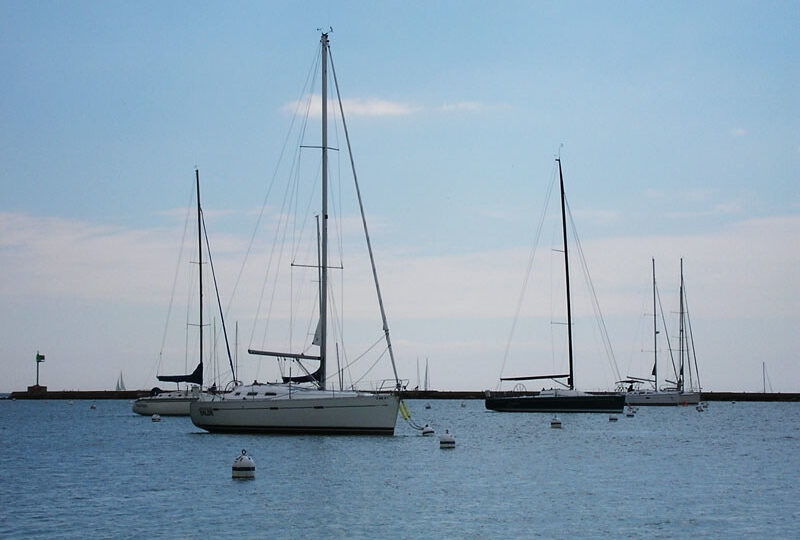
How Much Do Sailboats Weigh?
Sailing is an unquestionably wonderful experience. Cruising to new shores, relaxing in the sun, feeling the smooth breeze, racing, and other remarkable adventures are some of the things you can experience. Sailing gives us worthwhile and stimulating moments, but it also requires us to be aware of our sailboat’s characteristics. In this article, I’m going to refer to the factors affecting a sailboat’s weight, give you some examples, as well as provide you detailed information about them. Follow me!
Why Weight Matters?
The weight of sailboats is separated into three different categories of weight measurements: dry weight, displacement, and tonnage. Understanding the way in which each one of these methods function means understanding your sailboat’s weight. Each of these methods plays a crucial role in order to accurately determine a sailboat’s weight. For instance, dry weight and displacement are closely related. Displacement is a vital element for determining your sailboat’s capabilities. Heavy and deep-keel sailboats manage well in rough seas when you’re not racing with a high D/L ratio.
Keep in mind that there’s a lot of factors that affect a sailboat’s weight, like its hull type, length, mast and rig setup, gear, and onboard equipment. In order to know the dry weight of your sailboat, you’ll need to first determine if your vessel can actually tow it. Moreover, tonnage is also important, especially for long-passage cruising. With tonnage, you can calculate the number of supplies, water, and how many people you can take on board.
Towing and Vessel Capabilities
It’s of high importance to know the weight of your sailboat if you plan on towing it. In other words, its weight will determine if it can be towed, and with what type of vessels it can be towed. In case you wish to transport your sailboat to different areas with another vehicle, then you have to know your sailboat’s weight. The capabilities of your sailboat determine your sailboat’s weight. For example, if it’s able for racing or if it can handle rough seas, and how fast or far it can go.
Imagine placing your sailboat on a scale. The number that appears on the scale would be what we call dry weight. Dry weight is basically how much a sailboat weighs when it’s both empty and dry. In other words, the weight when there’s no extra weight on board. This type of measurement is important in case you plan on towing or transporting your sailboat with a vehicle. This is because the dry weight of your sailboat will be the weight you’ll have to tow. In addition, there are other things that affect the weight of the sailboat. These are the mast and rigging type, the hull material (wood or fiberglass), and deck equipment.
For example, solid hardwood masts often weigh hundreds of pounds more than hollow masts, as well as heavy brass deck equipment that also adds up weight. All these elements contribute to the dry weight of a sailboat and can make a significant difference in weight.
Displacement
Displacement is the most usual form of weight measurements in sailboats. When the weight of a sailboat is listed somewhere the displacement method is often used to define its weight. The displacement of a sailboat is equal to its weight, along with every other weight onboard at the time of measurement. This can include fuel, water, deck equipment, gear, etc. This method is called displacement due to the fact that measures the amount of water that the sailboat displaces. To give you a better idea about it, a sailboat has to weigh less water than the water it already displaces, otherwise, it could sink.
So, we calculate the weight of the water volume that the sailboat displaces. However, the displacement value of a sailboat differentiates in salt and freshwater. This happens because saltwater weighs 64.1 pounds per cubic foot, and freshwater weighs 62.4 pounds per cubic foot. And what does that mean? It means that a sailboat will displace more freshwater because saltwater basically has an upward direction towards the vessel.
Tonnage, size, and displacement are directly related. But, what exactly is tonnage? Tonnage is the volume of the sailboat’s internal space and also helps to define the cargo-carrying capacity within it. As for the freshwater and saltwater displacement’s difference, the same thing also applies to tonnage. Furthermore, cargo tonnage is measured in long tons, the same way with displacement. In other words, to get the cargo tonnage value you just divide the tonnage in pounds by 2,240.
Examples – Common Sailboats
- Small Sailboats : Small sailboats are considered the ones with an average length of 15 to 20 feet and an average weight of 400 to 2,500 pounds.
- Dinghies : Dinghies have an average length of fewer than 12 feet and their average weight is 100 to 200 pounds.
- Medium Sailboats : Medium-sized sailboats are those having an average length of 21 to 25 feet and an average weight of 2,500 to 5,000 pounds.
- Large Sailboats : Large sailboats are considered the ones with an average length of 35 to 40 feet and an average weight of 12,000 to 30,000 pounds.
- Cruising Sailboats : Cruising boats have an average length of 27 to 32 feet and an average weight of 7,000 to 12,000 pounds.
Examples – Weights of Popular Sailboat Models
- The Wayfarer (dinghy) is 15 feet 10 inches and weighs 400lbs.
- The Siren 17 has a length of 17.17 feet, and it weighs approximately 430lbs.
- The Catalina 16.5 Capri is 17.2 feet and weighs 430lbs.
- The Sea Pearl 21 is 21 feet and weighs 600lbs.
- The Hunter 22 has a length of 21,3 feet and weighs 2000lbs.
- The Jeanneau Sun 2000 is 21 feet 8 inches and weighs 2756lbs.
- The Beneteau First 235 is 23.3 feet and weighs 2826lbs.
- The Catalina 25 Capri is 24.6 feet and weighs 2950lbs.
- The Catalina 30 weight 10,200lbs
- The Jeanneau Fantasia 27 has a length of 27 feet 5 inches and weighs 3800lbs.
- The Cornish Crabber 22 is 27 feet and weighs 4480lbs.
- Sun Odyssey 30 is 29 feet 8 inches and weighs 7000lbs.
- The Catalina 350 is 35.4 feet and weighs 12,937lbs.
- Pearson 39 is 39.2 feet and 17000lbs.
- Beneteau Oceanis 40 is 39.9 feet long and weighs 18,210lbs.
- Beneteau Oceanis 45 is 45’9” and weights 23,257lbs
- The Valiant 40 weighs 23,500lbs
- The Hinckley Bermuda 40 weighs 20,000
- The Hallberg-Rassy 42 weighs 27,500lbs
- The Beneteau 57 weighs 47,500lbs
- The Jeanneau 54 weighs 37,840lbs
Common sailboats tend to weigh about 120 and 30,000 pounds. As for the average sailboat, this weighs around 8,845 pounds. Keep in mind that we refer to dry weight and don’t measure additional equipment, fuel, gear, etc. As aforementioned, in order to correctly weigh a sailboat, you’d need to take into account the three weight measurements. Furthermore, don’t forget that a sailboat’s weight is usually calculated without its engine, gear, water tanks, equipment, or persons in it. In short, an average sailboat of15-20 feet weighs around 1047 pounds. Moreover, the average weight of a 21-25 feet sailboat is around 2826lbs and the average weight of a 27-32 feet sailboats is 5410 lbs. Finally, the average weight of a 35-40ft sailboat is approximately 18,918 lbs .
Peter is the editor of Better Sailing. He has sailed for countless hours and has maintained his own boats and sailboats for years. After years of trial and error, he decided to start this website to share the knowledge.
Related Posts

Lagoon Catamaran Review: Are Lagoon Catamarans Good?

Best Inboard Boat Engine Brands

Are O’Day Sailboats Good? A Closer Look at a Classic Brand
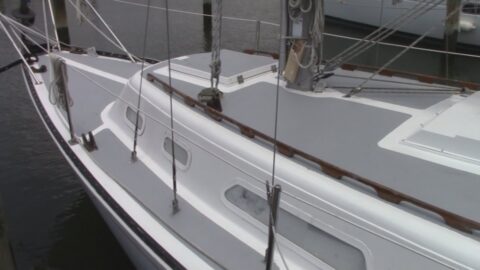
Best Non Skid Boat Deck Paints
- Buyer's Guide
- Destinations
- Maintenance
- Sailing Info
Hit enter to search or ESC to close.
- European Union
- South Africa
- Photos & Videos
Virtual Tour
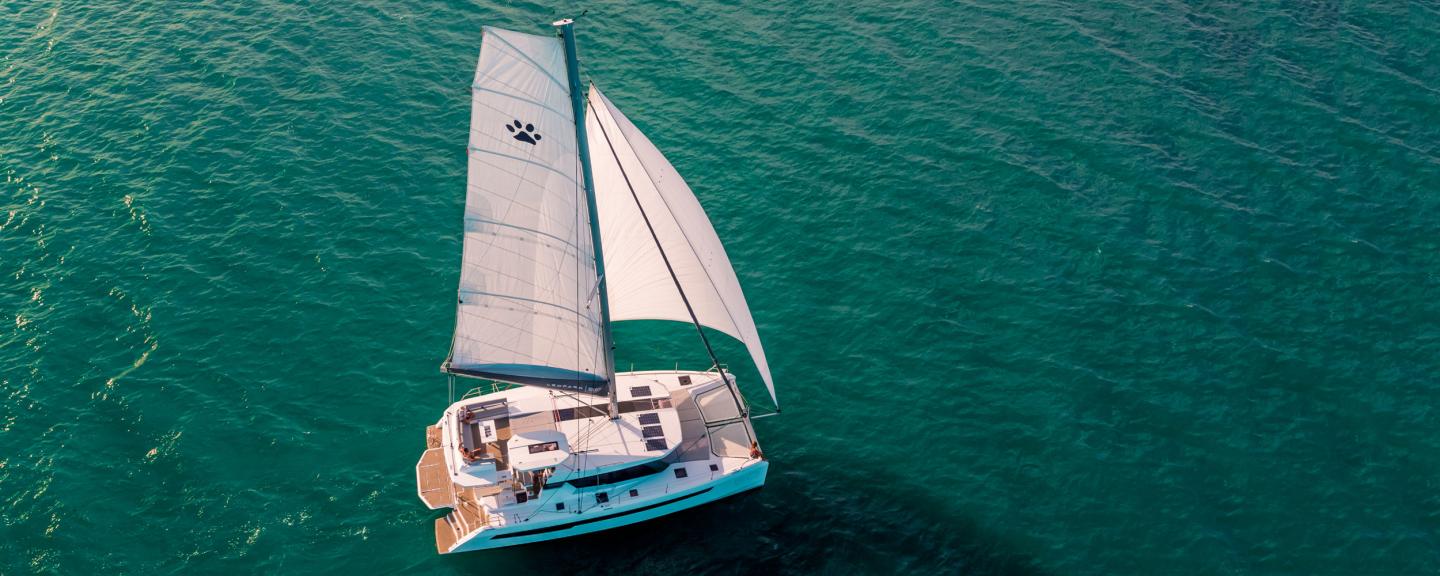
- Cabins: 4 or 5
- Heads: 4 to 6
- Berths: 6 to 12
- Showers: 4 to 6
SPECIAL OFFER


- LOA: 50 ft 6 in / 15.4 m
- LWL: 48 ft 11 in / 14.9 m
- Beam: 26 ft 5 in / 8.04 m
- Draft: 5 ft 3 in / 1.61 m
- Mast Height: 77 ft 2 in / 23.52 m
- Bridgedeck Clearance: 3 ft 5 in / 1.03 m
- Engine: 2x 57 hp
- Propeller Dimensions: 3‐blade 18in x 14in
- Engine No. Cylinders: 4
- Fuel: 243 gal / 920 L
EXTRA DETAILS
- Bunk Dimensions: View Leopard Range Bunk Dimensions
- Headroom: View Leopard Range Headroom Dimensions
- Water: 185 gal / 700 L
- Mainsail Area (Standard): 964 sqft / 89.6 sqm
- Mainsail Area (Square Top): 1019 sqft / 94.7 sqm
- Genoa Area: 688 sqft / 63.9 sqm
- Spinnaker Area: 204 sqft / 2199 sqm
- Code 0 Area: 970 sqft / 90.1 sqm
- Code D Area: 1690 sqft / 157 sqm
- Total Upwind Area (Standard): 1652 sqft / 153.5 sqm
- Polars: View Leopard 50 Performance Documents
- Displacement: 41888 lbs / 19000 kg
- Load Carrying Capacity: 15432 lbs / 7000 kg
- Holding Tank Capacity: 45 gal / 170 L
DOWNLOAD BROCHURE

Related Boat Reviews
Leopard catamarans feature - passagemaker, leopard 50: a most hospitable boat, leopard 50 review by multihulls world, related blog posts, lifetime partners in work and play: kevin and elizabeth's owner profile, product profile: leopard 50, owner reveal and test sail of the leopard 50p.
Make an appointment for a boat show, a sea trial, or simply receive a phone call from our expert agents.
Other Leopard 50 Buying Options
Check for current availability of used Leopard Catamarans and new Leopard Catamarans in charter programs on our sister sites

Boat Weights & Trailers: Types & Towing Tips
Ahoy, matey! Let’s dive into the fascinating world of boat weights, including 12 boat types, their lengths, and matching them with the appropriate trailers and towing vehicles.
You might be wondering, “How much does a boat weigh?”
Well, the answer isn’t quite as simple as you might think. Boats come in all shapes and sizes, and their weights can vary significantly depending on the type, size, and materials used.
In this article, we’ll explore the wide range of boat weights and discuss the types of trailers and vehicles you’ll need to tow your aquatic adventure machine. So, grab your life vest and let’s set sail!
How Much Do Boats Weight by Type
- Dinghies and Small Sailboats (100-1,000 lbs, 8-20 feet) These lightweight boats are perfect for beginners or casual boating enthusiasts. Due to their minimal weight, you can easily tow them with a small car or SUV. No need for a beefy truck or specialized trailer here! A simple single-axle trailer will suffice.
- Aluminum Row Boats (100-500 lbs, 10-20 feet) Aluminum row boats are durable and lightweight, making them easy to transport. A small car or SUV can handle towing these boats with a basic single-axle trailer.
- Personal Watercraft (PWC) (400-1,000 lbs, 8-12 feet) Jet skis and other personal watercraft are popular choices for those seeking a thrilling experience on the water. They’re relatively light, so towing them shouldn’t be a problem for most vehicles. A simple PWC trailer should do the trick.
- Bass Boats (1,500-2,500 lbs, 16-22 feet) Bass boats are designed for fishing in shallow waters, and their sleek design allows for easy maneuverability. They typically weigh between 1,500 and 2,500 lbs, meaning a midsize SUV or truck can tow them with ease. A single-axle or tandem-axle trailer will work well for these boats.
- Bowriders (3,000-5,000 lbs, 18-30 feet) Bowriders are versatile boats with an open bow area for seating. They’re perfect for a day of fun with family and friends. Weighing between 3,000 and 5,000 lbs, you’ll need a larger SUV or truck to tow these boats. A tandem-axle trailer will be the best choice for these vessels.
- Cuddy Cabin Boats (2,500-4,000 lbs, 18-25 feet) Cuddy cabin boats offer a small sheltered area with limited sleeping accommodations, making them a popular choice for day trips and weekend getaways. They generally weigh between 2,500 and 4,000 lbs (dry), and a larger SUV or truck with a tandem-axle trailer is recommended for towing. Link leads to article dedicated solely to cuddy cabin boat weights.
- Pontoon Boats (1,500-5,000 lbs, 16-30 feet) Pontoon boats are known for their stability and spaciousness, making them excellent choices for leisurely cruises or parties on the water. Depending on the size, you may need anything from a midsize SUV to a full-size truck for towing. A tandem-axle trailer is commonly used for these boats.
- Cabin Cruisers (6,000-12,000 lbs, 25-40 feet ) Cabin cruisers offer a comfortable space for overnight stays and often come with amenities like a small kitchen and bathroom. Due to their size and weight, you’ll need a heavy-duty truck and a sturdy boat trailer with tandem or triple axles to tow these vessels.
- Sailboats (4,000-20,000+ lbs, 20-50+ feet) Sailboats can vary greatly in weight, depending on their size, hull material, and rigging. Smaller sailboats weighing 4,000-8,000 lbs can be towed with a full-size truck, while larger, heavier sailboats may require specialized transport. A tandem or triple-axle trailer is necessary for these boats.
- Yachts (30,000+ lbs, 40-100+ feet) Yachts are the epitome of luxury on the water. Due to their massive size and weight, they typically require professional transport, either by water or by specialized land trailers. Towing a yacht isn’t a job for your everyday vehicle!
- Speedboats (2,500-8,000 lbs, 20-35 feet) Built for speed and excitement, these boats can vary significantly in weight. Smaller speedboats might be towed by a midsize SUV, while larger, more powerful models will require a full-size truck or even a heavy-duty truck to handle the load.
- Houseboats (15,000-50,000+ lbs, 40-75+ feet) Houseboats are like floating homes, offering all the comforts of a house on the water. Due to their immense size and weight, houseboats usually require specialized equipment and professional services to transport them.
Understanding Dry Weight
When discussing boat weights, it’s essential to differentiate between a boat’s dry weight and its total weight when fully loaded.
The dry weight refers to the weight of the boat without any additional gear, fuel, or passengers. It’s the base weight of the boat, which includes the hull, engine, and essential onboard equipment.
However, dry weight does not account for the weight of items that are often added to the boat, such as personal belongings, provisions, or optional equipment.

Heaviest Items to Consider
When calculating the total weight of your boat, it’s crucial to consider the weight of all the items you’ll be bringing on board. Some of the heaviest items that can significantly impact the total weight of your boat include:
- Fuel: Gasoline and diesel fuel can weigh a lot, especially when you have large fuel tanks. Gasoline weighs roughly 6.1 lbs per gallon, while diesel weighs around 7.1 lbs per gallon. Take note of the capacity of your fuel tank and do the math.
- Water: Drinking water and water for onboard systems (such as sinks and showers) can add a significant amount of weight to your boat. Water weighs approximately 8.3 lbs per gallon . Take note of the capacity of your water storage on board and do the math.
- Waste Tanks: If your boat is equipped with a marine toilet and waste holding tank, the weight of the wastewater can also add up. This weight will vary depending on the size of your tank and how full it is.
- Batteries: Each marine battery on board will likely add an additional 60-75 pounds.
- Gear and Equipment: Items such as anchors, ropes, life jackets, coolers, ice, fishing gear, and other personal belongings can quickly add weight to your boat.
- Passengers: Don’t forget to account for the weight of passengers and pets when calculating your boat’s total weight.
When determining the towing capacity required for your boat, it’s important to consider the total weight, including all the additional items you’ll be carrying on board. By taking these factors into account, you’ll be better prepared to safely tow and operate your boat within its specified weight limits.
Boat Trailer Weight Ranges Based on Axles
Boat trailers come with different axle configurations that affect their weight capacities. The number of axles determines the overall weight a trailer can safely carry. Here’s a general overview of boat trailer weight ranges based on the number of axles:
- Single-Axle Trailers: Single-axle trailers are typically designed for smaller boats and have a weight capacity ranging from 1,500 to 3,500 pounds. They’re suitable for towing lightweight boats such as aluminum fishing boats, jet skis, or small sailboats. Single-axle trailers are generally more maneuverable, easier to handle, and more cost-effective than trailers with multiple axles.
- Tandem-Axle Trailers: Tandem-axle trailers, which have two axles, offer increased stability and can handle larger, heavier boats. These trailers can typically support boats weighing between 3,500 and 7,000 pounds. Tandem-axle trailers are ideal for towing medium-sized boats like ski boats, pontoon boats, or small to mid-sized cabin cruisers.
- Tri-Axle Trailers: Tri-axle trailers feature three axles, providing even more stability and support for larger, heavier boats. They can typically accommodate boats weighing between 8,000 and 18,000 pounds or more. These trailers are suitable for towing large boats such as houseboats, larger cabin cruisers, or yachts.
It’s essential to choose the right trailer for your boat based on its weight, including the additional weight of gear, fuel, and water. Always consult the trailer manufacturer’s specifications and recommendations to ensure safe and proper towing.

Common Vehicle Types and Their Towing Capacity Ranges
Different vehicles have varying towing capacities, which determine the maximum weight they can safely tow. Here’s a general breakdown of common vehicle types and their towing capacity weight ranges:
- Compact Cars: Most compact cars have a limited towing capacity of around 1,000 to 2,000 pounds . These vehicles are suitable for towing small boats, such as jet skis or aluminum rowboats.
- Sedans: Midsize and full-size sedans typically have a towing capacity ranging from 2,000 to 3,500 pounds . This allows them to tow small boats like aluminum fishing boats, small sailboats, or lightweight personal watercraft.
- Crossovers and Small SUVs: Crossovers and small SUVs usually have a towing capacity between 3,000 and 5,000 pounds . This capacity makes them suitable for towing small to medium-sized boats, such as bass boats, ski boats, or smaller speedboats.
- Midsize and Full-Size SUVs: These vehicles have a higher towing capacity, generally between 5,000 and 8,000 pounds . Midsize and full-size SUVs can tow larger boats, like cabin cruisers or cuddy cabin boats, and may even be able to handle some pontoons and wakeboarding boats.
- Pickup Trucks: Pickup trucks are known for their powerful engines and substantial towing capacities. Light-duty pickup trucks can tow between 5,000 and 12,000 pounds , while heavy-duty trucks can handle anywhere from 12,000 to 30,000 pounds or more . These trucks are capable of towing larger boats, such as larger cabin cruisers, houseboats, and even some yachts.
It’s crucial to consult your vehicle’s owner’s manual or contact the manufacturer to verify the specific towing capacity of your vehicle. Remember that towing a boat safely requires a combination of the right vehicle, proper trailer, and appropriate hitch.
Also remember that once you get to the water you’ll be backing up your vehicle down a ramp and into the water, so you’ll need the brakes and vehicle capability of dealing with that. It’s not just highway driving that you need to think about.
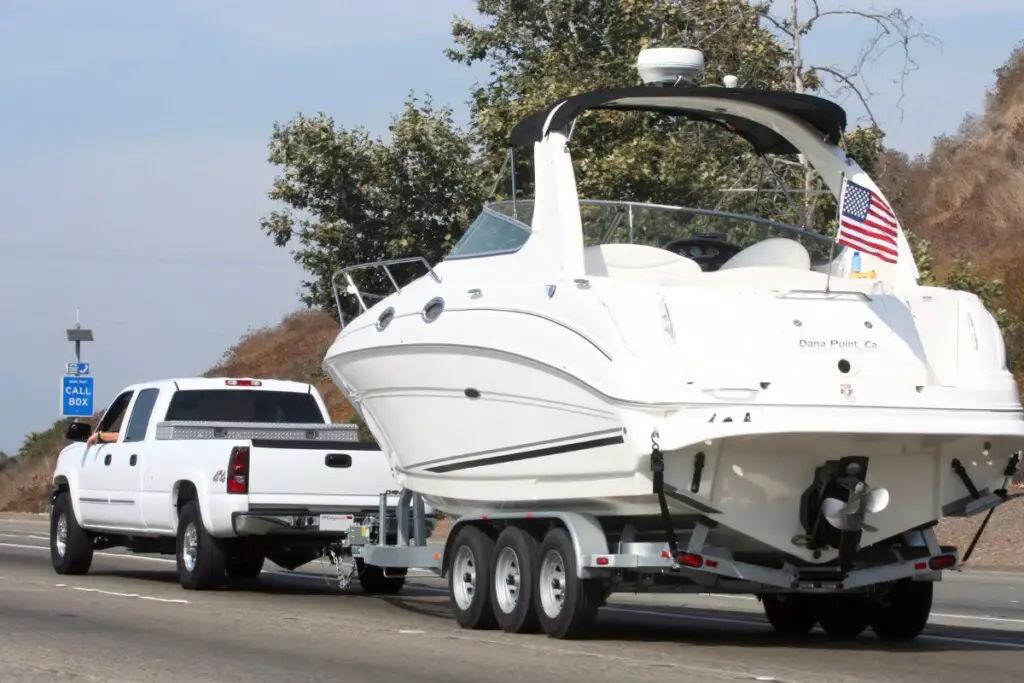
Final Takeaways
The weight of a boat can vary greatly depending on its type, size, and materials used in its construction. When towing a boat, it’s essential to have the appropriate trailer and vehicle to ensure safe and efficient transportation. By understanding the different boat weights and towing requirements, you’ll be better equipped to choose the perfect setup for your aquatic adventures.
Happy Boating!
Robert Van Nuck
Robert lives in central Michigan and enjoys running, woodworking, fixing up small engines, and getting out on the water with family, of course! He is also the owner and author of homebatterybank.com.
Recent Posts
Glare No More: Selecting the Perfect Boating Sunglasses
Sunglasses are a vital accessory for boaters that provide protection from the sun's harmful rays while enhancing visibility. Boating takes place in an environment where the sun reflects off the...
Aluminum vs. Fiberglass Boats: Which is Better for You?
In the world of boating, there are two materials that dominate the market: aluminum and fiberglass. Both have unique advantages and disadvantages that make them suitable for different types of...

How Much Do Boats Weigh? 11 Boat Types Explained
Boats come in all different sizes and weights.
This can make it tough for people trying to find out whether or not they have the ability to tow certain boats with their cars and trucks.
In this post, we’ll try to make it easier by showing you the average weight of a wide variety of boats in different classes and sizes.
Here’s How Much Boats Weigh on Average
Smaller aluminum fishing boats typically weigh around 400 pounds and a 14 feet cabin cruisers will often weigh around 14,000 pounds. A superyacht can weigh up to 100,000 pounds.
Table of Contents

Here are some general boat weights to consider before we get into the details:
Aluminum Fishing Boats

The average aluminum fishing boat is about 16 feet in length.
It generally consists of the hull, a set of benches or chairs, and a center console for steering the vessel.
In some cases, the center console might be traded out for a seat near the engine instead. At the rear is an outboard gas engine or a small electric motor . Boats with rear gas engines will often have an electric trolling motor at the front as well.
The boat might have a deep v, a modified v, or a flat bottom.
Boats with a deep v will have a larger hull and a larger engine and will, therefore, weigh more than flat bottom boats. A flat bottom boat can sometimes go by the name Jon boat.
Related Article: How Long Do Sailboats Last?
These boats are meant to be used for fishing, and they are usually lightweight. This is nice because it gives people with a wide range of vehicle types the opportunity to buy a fishing boat that they can safely tow.
In fact, most of these boats will weigh less than 500 pounds without an engine.
The tow weight will usually be less than 1,000 pounds.
Here are some quick examples:
The Lund WC-16
This boat has a small gas engine and bench seats. It’s a semi-v, and it is steered from the rear.
The weight is 325 pounds on this boat, without the engine.
Alumacraft 1648 Jon
The 1648 is a flat-bottom boat that does not come with an engine.
It has three benches and is meant to be steered from the rear.
The weight of this boat is 320 pounds.
Bowrider Boats

Bowrider boats are great for short cruises and are usually meant with seating comfort in mind.
They will often have an inboard motor at the rear but can also be equipped with an outboard motor instead.
These boats are steered from a console, and there is a windshield protecting the driver as well as the person next to the driver.
Related Article: How Much Gas Do Boats Use? 5 Boat Types Explained
Bowrider boats come in a lot of different lengths, but the most popular length seems to be 21 feet.
The main material used to make this boat is fiberglass.
Fiberglass is heavier than aluminum, so this adds some weight to the boat.
Here are some examples of bowrider boats:
Regal 21 OBX
The Regal 21 is a 21-foot fiberglass bowrider with an outboard motor. It can hold up to 10 passengers and has a large wrap-around windshield.
The dry weight on this boat is 3,250 pounds.
Yamaha Boats SX210
This boat is a 21-foot long boat with a fiberglass hull.
It has an inboard motor and a nice deck at the rear of the boat.
Additional features include a large windshield, wraparound seating near the steering console, and a set of lounge chairs at the bow. There is also a built-in ladder at the rear for boarding.
The weight on this boat is 3,172 pounds.
Cabin Cruisers

A cabin cruiser is essentially a small yacht that ranges in size between 25 – 45 feet.
These boats have large fuel tanks and will often feature more than one engine.
They’re meant for long distances and come equipped with everything one would need to travel for days or even weeks at a time.
Related Article: How Do You Find the Owner of a Boat? (With Examples)
Inside of a cabin cruiser, you’ll find a head, a berth, and usually a dinette and galley. The larger the cabin cruiser, the more living quarters you’ll find inside of it.
These boats vary in weight, but a 35 footer will usually range in weight from 12,000 to 16,000 pounds.
Here is an example of a cabin cruiser:
The Regal 35 Sport Coupe
This boat is a 37-foot long craft with sunbathing decks on the bow and the stern of the boat. It has an inboard motor with a fantastic deck built into the stern for getting in and out of the water.
The fuel tank on this boat is 158 gallons, and the freshwater capacity is 50 gallons.
There is also a waste tank that can hold up to 30 gallons.
This boat weighs 13,300 pounds.
Cuddy Cabins

Cuddy cabin boats are a cross between bowrider boats and cabin cruisers.
They have the short-term cruising capabilities of a bowrider, but they also have a small area to sleep or eat inside.
This area usually consists of nothing more than a berth or a berth that can be converted into a dinette. It is great for people looking to spend a night out on the water but not very good for people looking to spend an entire weekend out there.
Related Article: 13 Clever Ways to Get a Good Deal on (New) Boats
A cuddy cabin is somewhat larger than your average bowrider but smaller than a cabin cruiser. You can expect to find them in the 20 to 30-foot range.
These boats usually weigh between 3,000 and 5,000 pounds.
Stingray 208CR Cuddy Cabin
This cuddy cabin is 21 feet long and has a fuel capacity of 34 gallons.
The water capacity is only 6 gallons, so its wet weight wouldn’t differ much from its dry weight.
The boat has outside seating for about four people while in motion and seating inside the interior space for two to three people.
The stern of the boat has a padded deck that you could sit on, but I wouldn’t do so while in motion.

Deck boats are built for day cruises and family fun. Their design gives them a lot of deck space so that you can bring your large family or a bunch of friends out on the water with you.
These boats are similar to pontoon boats in that they offer a lot of room to move around. However, they are built with a traditional hull, so they stand up to rough water better than a pontoon boat.
The size of this boat usually ranges between 20 and 30 feet. Expect these boats to weigh between 3,000 to 5,000 pounds.
Here is an example of a deck boat:
The Bayliner 210 Deck Boat
The 210 is a 21-foot deck boat with an 8’6″ beam.
It weighs 3,468 pounds dry and 5,200 pounds dry if you include the trailer. This weight includes a 150HP outboard engine.
A large SUV or small truck should easily be able to pull this boat, and at 8’6″ wide, it is perfectly trailer-able.
Related Article: 33 Hilarious Boat Jokes To Make You Laugh
The boat is set up so that the only true chair on the boat is the captain’s chair. Next to this chair, you’ll find an L shaped bench that can be used for people to sit on or lounge on.
At the bow, you’ll find a set of two benches that could also be used as lounge chairs.
Fiberglass Fishing Boats

Fiberglass boats weigh more, but they are often more durable, and the hull designs on them can often be more complex.
As a result, you get a boat that handles better in the water, and that should last a lot longer.
These boats cost more to buy, but they also depreciate slower, so you generally don’t lose out financially when you buy one.
A fiberglass boat can come in all sorts of sizes, but in this post, we’ll be comparing this boat’s weight to that of the smaller aluminum fishing boats.
This puts the boat in the 16 to 20-foot length range.
The weight on these boats is usually between 1,500 and 2,500 pounds without the motor. With a larger engine and a trailer, you could be looking at a weight that is well over 5,000 pounds.
Here is an example of a fiberglass fishing boat:
The Grady White Fisherman 180
This fiberglass fishing boat is a center console fishing boat.
It has a reversible bench seat behind the console and a seat directly in front of the console.
There is a raised casting platform on the bow of the boat and a set of cushioned seats at the stern. A swim platform with a ladder also resides at the stern.
Pontoon Boats

A pontoon boat is basically a flat deck mounted over two or three pontoons.
These boats are a lot of fun to cruise on as there is plenty of space to move around on them.
Some of these boats even have built-in grills so that you can throw barbecues on them.
These boats will often weigh in the neighborhood of 5,000 pounds with the engine and the trailer, so they are towable, but you won’t be able to tow the larger ones with a car, crossover, or minivan.
You can find 9 examples of pontoon boats with our Pontoon Boat Weight Guide: 9 Examples (& Pictures)!
Sailboats Between 14 and 20 Feet

Sailboats come in all different lengths and weights, so we’ll break them into a couple of categories. A sailboat between 14 and 20 feet is usually known as a day sailboat.
These sailboats are primarily used in protected waters like bays and inlets or on lakes and rivers.
They can be made from wood or fiberglass, and you can buy mass production sailboats as well as a wide array of custom-made sailboats.
Small sailboats like this don’t weigh much as they don’t have gas engines or fuel tanks. They also lack living quarters so you won’t find heavy amenities or water tanks.
Expect them to weigh somewhere between 400 and 800 pounds.
Here are some examples of small sailboats:
The West Wight Potter 15
The Potter 15 is a 15-foot sailboat with a sloop design and a small cuddy area for sleeping. It has teak cabin top handrails and a stainless steel transom boarding ladder.
This boat doesn’t have much on it other than two places to sit, and a place to sleep. It weighs in at 473 pounds without the trailer and just under 1,000 with the trailer.
In fact, the West Wight website shows a mini-cooper pulling it.
The Catalina 16.5
The Catalina 16.5 is a 17-foot sailboat with a roomy seating area.
It does not have a sleeping area, but there is a large locker at the bow for storage.
This boat weighs in at 429 pounds.
Sailboats 20 to 30 feet in length

Sailboats between 20 and 30 feet can be used as day cruising boats, or they can be outfitted with cabins for weekend getaways.
They can weigh anywhere from 4,000 to 8,000 pounds.
Sailboats that are larger than 30 feet are generally considered to be yachts. At that point, you probably won’t be too worried about how much the boat weighs as you won’t be able to tow it anywhere anyway.
Here are a few examples of sailboats with lengths between 20 and 30 feet.
The Marine Concepts Sea Pearl 21
The Sea Pearl 21 is a no-frills sailboat that is built for day cruising.
It is wide open, and there isn’t any place to sleep, let alone to get shelter from the sun.
Without a motor or any extras, the Sea Pearl 21 weighs in at around 600 pounds. This is about the best you can expect from a boat this long.
The Stuart Knockabout
The Stuart Knockabout is marketed as an upgrade over a smaller daysailer but more simple in its build when compared to a large cruiser. It has a classic look to it, and if you dropped it onto the bay 40 years into the past, it probably wouldn’t look out of place.
This boat is 28 feet long, 8’6″ wide, and it weighs in at 4,000 pounds.
With these dimensions and this weight, it’s still easily towable.
The C&C 29 is made by Cuthbertson & Cassian, and it is a Canadian built sailboat.
This boat was originally designed for speed, but it functions perfectly well as a sailing yacht.
Inside there is a head, a galley, a berth, and a comfortable dining area.
This boat is just over 28 feet long, and it weighs in at 7,500.
Also, it is over 9 feet wide, so even if you have the truck to tow it, it will be considered an oversized load on the road.

A skiff is meant for shallow water.
Anglers love them because of their ability to get in and out of tight fishing spots.
These boats can be used with small motors, or they can be moved along with a long pole.
They’re typically under 20 feet, and they’re designed to be lightweight so that they can easily be poled through the water. The lighter the skiff, the easier it is to get it moving without an engine.
Here are some examples of skiffs:
Xpress Boats Skiff 185
This boat has a length of 18’5″ and a beam of 83″. It is made from 5052 gauge aluminum, and it has a bench seat behind a center console.
The weight of this boat is 950 pounds, so it is easy to tow, but it could be a little difficult to pole for long periods of time.
Hell’s Bay Boatworks Eldora
The Eldora is just over 16′ long, and it has a beam of 69″.
It is a shallow boat with a draft of only 3.5 inches. This makes it a perfect shallow-water boat.
On top of this, the Eldora weighs only 350 pounds, so it is easy to pole manually.
When not poling, it has a Yamaha 25 engine and a 6-gallon removable gas tank.

Wake boats are for watersport enthusiasts who want to wake surf. These boats are designed to create waves behind the boat for wake surfers to have fun on, so they’re definitely a niche item.
A wake boat is typically in the neighborhood of 20 feet long, and they generally have dry weights between 3,000 and 5,000 pounds.
Here are some examples of wake boats.
The Yamaha 212X
The 212X is a little over 21 feet, and it has a beam length of 8’6″.
It seats up to 10 people and can hold 50 gallons of fuel in its fuel tank.
This boat has a dry weight of 3,616 or 4,612, depending on whether or not you count the trailer. A small truck or large SUV could easily handle a boat of this size.
The Supra SR
The Supra SR is a 21′ boat with a beam width of 102″.
It can seat up to 14 people, and the engine has a 45-gallon fuel tank. This engine is either a 400HP engine or a 450HP engine.
This boat has a dry weight of 4,950 pounds, but when you add the trailer, it jumps up to 6,450 pounds.
As a result, you’ll need either a large SUV or a midsize truck to tow the boat comfortably.
Final Thoughts
Different types of boats and different boat models will all have different weights associated with them.
On top of this, different trailers and engines will have different weights that you’ll have to consider as well.
When buying a boat, make sure you consider the boat’s weight with the engine, the trailer’s weight, and even the weight of the fuel, water, and gear that you’ll have inside of the boat during transit.
Click to share...
48-50ft Catamaran Models Comparisons
We compare the specifications, dimensions, sail area, and pricing on the most popular 48-50ft catamarans in 2020. The Lagoon 50 , Bali 4.8 , FP Saba 50, and Leopard 50 are within a similar price range and dimensions, but there are major differences. Let’s compare apples to apples to see how the match up.
48-50 Ft Catamaran Model Specifications
48-50 ft catamaran deck layout comparisons, 48-50 ft catamaran flybridge layout comparison, 48-50 ft catamaran sail plan comparisons, 48-50ft catamaran cabin layouts comparisons, 3-cabin layout, 4-cabin layout, 5-cabin layout, price lists & specifications.
For more information, price lists, specifications, or available charter programs, contact us to discuss and view these catamaran models.
Estelle Cockcroft
Join our community.
Get the latest on catamaran news, sailing events, buying and selling tips, community happenings, webinars & seminars, and much more!
Leave a Comment Cancel Reply
Your email address will not be published. Required fields are marked *
Save my name, email, and website in this browser for the next time I comment.
Recent Posts
First-annual virgin islands boating exhibition (vibe).
VIBE – It’s a Destination Boat Show! Join us May 10 – 12 at
BALI Catamarans Unveils The New Bali 5.8 Flagship
CATANA GROUP launches its 14th BALI CATAMARAN model, the BALI 5.8, for the brand’s
Love Stories At Sea…because it’s valentine’s day
Because it’s Valentine’s day, we wanted to celebrate all the couples that we helped
Your Go-To Resource for all your Catamaran Needs!
Check out our brochure to learn about all we have to offer and why
For more than 30 years, we have been a part of the catamaran community and created Catamaran Guru™ to encourage and educate all the aspiring sailing out there. We understand the dream of traveling the world by catamaran and created a one-stop-shop to make that dream a reality for you.
- Stephen & Estelle
- Testimonials
Get Started
- Yacht Sales
- Used Yachts
- Charter Management
- Boat as Business Programs
- Seminars & Events
- PERFORMANCE TOPICS
- How much do multihulls weigh

Weight and displacement
C ause for confusion
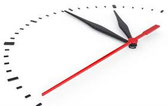
Building hours for multihulls
Building hours can vary considerably from one yard to another, but also from one boat to another in the same yard, even when the designs are very similar.
Building hours are difficult to nail down but we provide some pointers in this article.

How much do multihulls weigh? We provide some real world data and show how to put it to good use.
MULTIHULL WEIGHT AND LENGTH COMPARED
We'd all like our next set of wheels to be a cool sports car with room to pick up the kids from school, do a bit of shopping, and maybe make the occasional trip to the hardware store. But we understand we're going to have to compromise somewhere. Same with boats. First across the line will probably not be the most comfortable cruising boat unless it's big and/or expensive.
But how do you decide how fast you can go without sacrificing too much room, or without having to go bigger and more expensive? The purpose of the information in these plots of boat weight against length is to give an indication of what's achievable in the real world for fairly conventional construction methods and materials, and a relatively modest budget.
A lot of the boats on the plot are well known world wide including the Seacart 30, Corsair 36, the Multi 50 Arkema, G32 Foiling cat, the Gunboat G4, an ORMA 60 and a typical Gunboat 60 (weight estimated) which is off the page in the top right hand corner of the first plot.
Comparison Data
In the interest of finding a standard measure by which to compare a wide range of multihulls we’re going to use the measured weight (WM) component of the OMR Rule because it provides us with a wealth of readily accessible and reliable data.
We have also included some weights of boats that have been measured for other rating rules using similar standard, or where we believe the weight figure provided is reliable.
WM is defined in clause 6 of the OMR Preamble as follows:
Weight of the vessel shall be measured with all fixed equipment and accessories which will be carried during racing as documented in the inventory but without crew, crew personal kit, or consumables, including water and fuel. The vessel must be dry and all bilges and lockers open for inspection.
The full text of the OMR Preamble can be found here.
The chart plots in this article are built on our data base which currently comprises 109 catamarans and trimarans, 97 of which we have official OMR weights to work with.

The big picture 22' - 60'
This is the big picture graph that plots the weight against length trend line for catamarans and trimarans up to 60' LOA and also includes a MOD70 which is off the scale to the right. The blue line is the trend line for catamarans which are represented by blue squares. The grey line is the trimarans. Some images to follow will zoom in on various parts of the graph so you can read boat names.
It's interesting that the plot lines cross over at about the 40' mark with cats becoming relatively heavier as size increases. We shouldn't try to read too much into this in terms of the weight of the bare structure. It's a natural consequence of cats being preferred for long term cruising in the larger size range while trimarans are the weapon of choice for ocean racing. They employ exotic materials, refined engineering and meticulous manufacture to achieve low weight.

ZOOM BOX 1 - 35' TO 54' LOA
The plot above focuses in on the 35' to 45' size range. The three trimarans Arkema, Carbon3 and 3 Itch are all sitting well below the trend line. Three Itch is the only one of these three for which which we have an OMR weight. Jessica Rabbit is sitting above the line but we used a weight figure provided by Martin Fischer which is an estimate of sailing weight including crew and equipment. Jessica Rabbit would sit closer to the black line under an OMR measurement.
Arkema's number is the quoted "displacement". If that is the actual weight it's a very light boat for its size but if we were to draw a trend line for Gunboat G4, Arkema, the ORMA 60 and MOD 70 all of these four boats would be close to that line. They are also all quite high tech construction.

ZOOM BOX 2 - 35' TO 45' LOA
The six Stealth catamarans (shown by the red squares) which are built by Asia Catamarans in Thailand provide an excellent benchmark for a high performance lightweight cruising catamaran that doesn't use exotic materials or construction methods. Most of the these boats have carbon rigs and synthetic rigging and they employ carbon in high load areas but are otherwise relatively conventional in construction using foam core with epoxy/glass skins. The three Corsair 36 trimarans are firmly above the line even though two of them were built in carbon.

ZOOM BOX 3 - 22' TO 33'' LOA
This plot in the 22' to 34' size range is mostly made up of trailerables. Trimarans on the black trend line and grey triangles, cats in blue squares. We didn't have enough cats under 30' in the data base to reliably carry the catamaran trend line into this plot.
GETTING BELOW THE LINE
Leaving aside the fitout and inventory that goes on the boat (we discuss that in another article) there are three critical elements to a light boat; engineering, materials and build methodology.
Engineering is critical for understanding the loads on the structure, having a good knowledge of the materials properties and applying the materials accordingly. Connecting loads with material properties means that a close working relationship between the builder, the designer the materials people and the composites engineers is absolutely fundamental. Where this relationship doesn't exist the materials specification has to be more conservative. That's one good reason why light boats take more time, more expertise and more effort, and consequently are more expensive.
Material selection is critical for making sure things are as strong and as stiff as they need to be. Carbon won't make for lighter hulls but it will reduce the weight and provide added stiffness in load critical structures like beams, rigs and foils. PVC foam is the ideal core unless you go to honeycomb cores - but that puts you in a whole new price bracket and ups the build skills requirements.
Build Methodology involves good laminating practice; getting the right fibre ratios and resin cure times and achieving good secondary bonding. If the engineer or designer is not sure of the level of skill on the shop floor then once again the specification needs to be conservative.
All of the boats that we see below the line on these plots have been built with due attention to these elements and the further they are below the line the more they will have focused on these elements in the respective design and build stages.
Join the Newsletter

- Scroll to top

Boat Weight Calculator
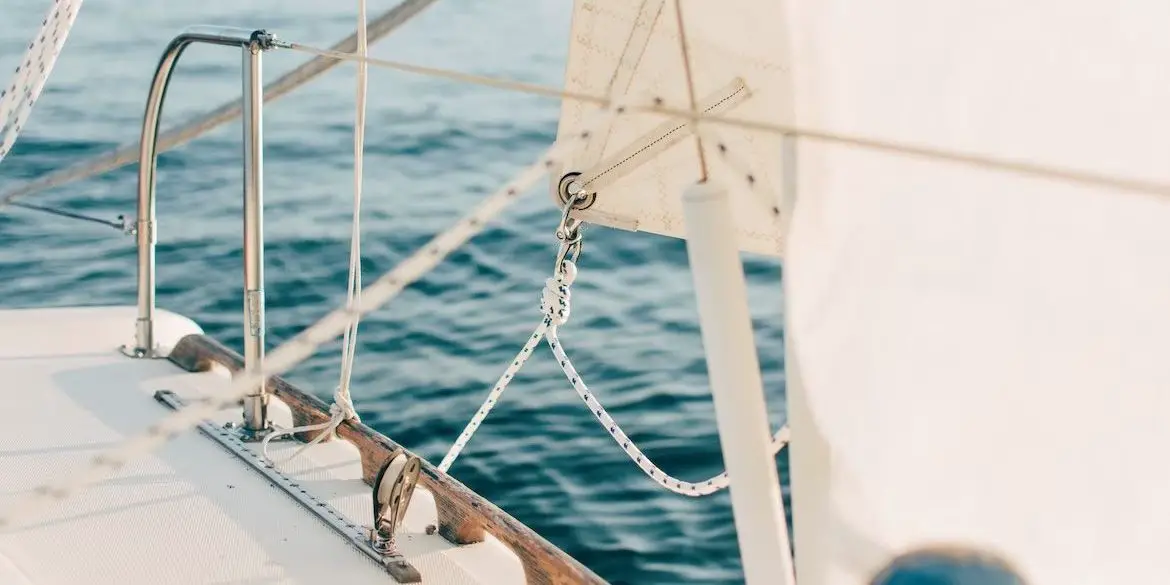
This calculator will help you estimate the total weight of your boat by considering various factors such as dry weight, fuel and water capacity, holding tanks, and more. Please fill in all the required fields and select your preferred units.
Estimated Total Weight:
Please note that the calculated weight is an approximation and may not be completely accurate. Always consult the boat manufacturer for precise specifications.

You Might Also Like

How to Register a Boat in Florida (2023)

Boat Calculators
How Much Do Boats Weigh? (Weight Chart)
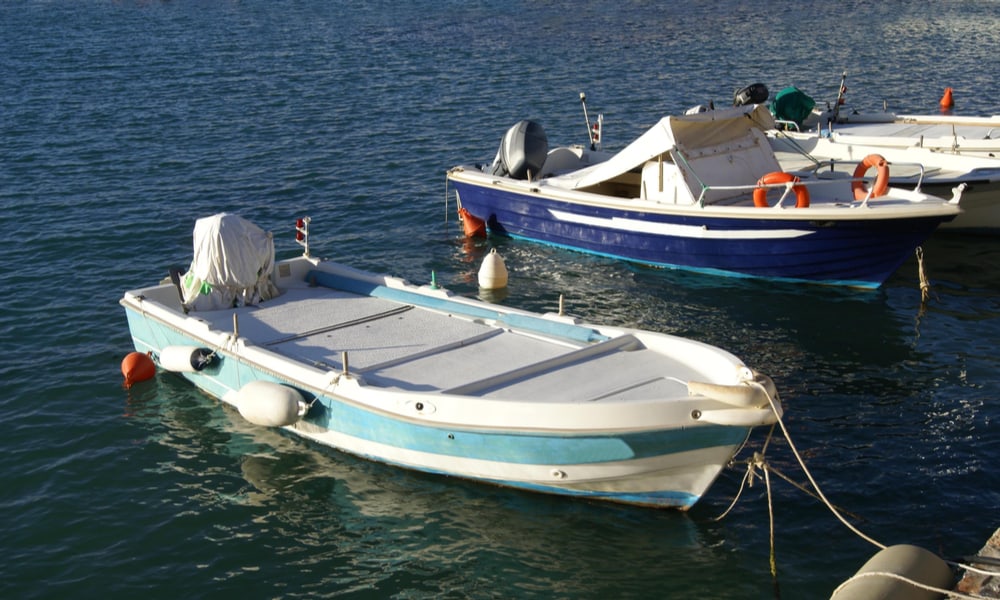
Boating is one of the favorite leisurely activities worldwide. If you can buy a boat , you should do so. However, you need to check a few crucial things before taking such a step. For instance, it is crucial to know how much do boats weigh and the appropriate length that will suit your needs.
This information is not crucial while your vessel is on the water but will help you find a way of transporting your boat. If you want a more sizable vessel model, you may need to change your vehicle because of its towing ability. Plus, its weight will affect the trailer type you need. Let’s see.
Table of Contents
Dry Weight vs. Wet Weight
The most towable boats, vehicle towing capacity.
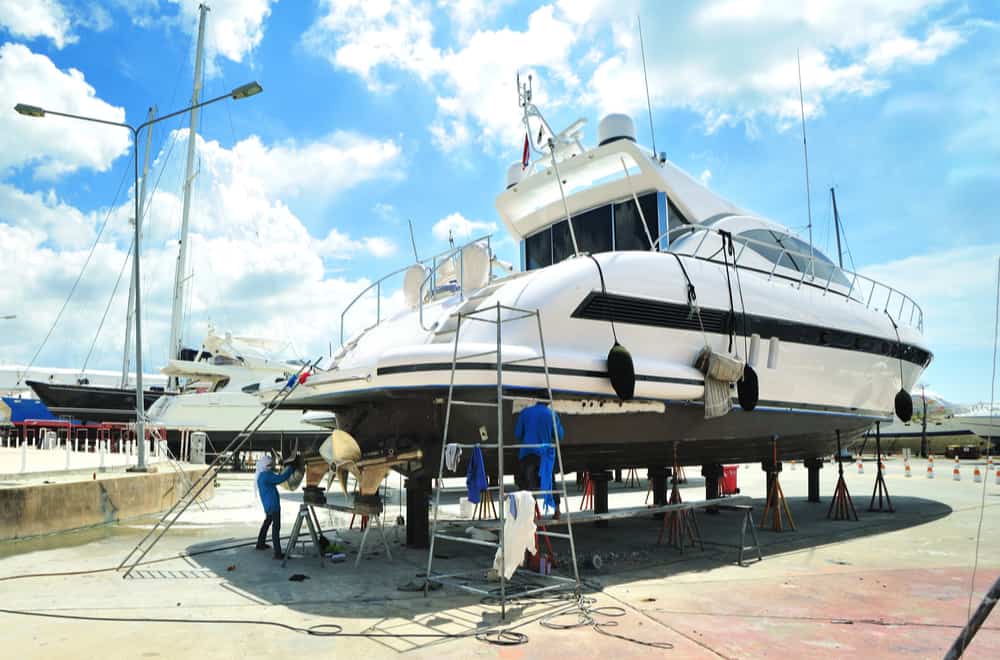
The primary thing before determining how much do boats weigh is to know what does it really mean.
This boat’s dry weight is its mass you can find on the manufacturer’s instructions. It includes only a vessel without an engine, fuel, equipment, passengers, and trailer .
This measure includes the weight of the boat with an engine and fuel. Be careful when determining it since motors are heavy and can carry gallons of gas.
Remember that each gallon (3.8 l) of fuel weighs 6 pounds (2.7 kg). In other words, an average tank with 60 gallons (227 l) capacity will add at least 360 pounds (163 kg) to the boat’s dry weight.
Package weight
This weight type includes a boat with an engine packed with fuel and trailer weight. It is the weight your car needs to tow once you decide to transport the boat. Remember that a trailer size directly depends on your vessel length and weight.
Actual boat weight
It is the weight of your fully-equipped vessel with a trailer . It includes a boat with a fully fuel-filled engine, passengers, and gear, like:
- Fishing gear
When these things add up, they significantly increase the final boat’s weight. Unfortunately, it is impossible to precisely calculate this measurement since the equipment is not standard and depends on your needs and boat type.
However, you can check the weights of gear most people typically carry on their vessels. Then, you can pick out things you plan to load on your boat and make a calculation.
- The trailer is approximately 1,000 to 1,600 pounds (455 – 725 kg) heavy
- Fuel weighs 240 to 450 pounds (110 – 205 kg), depending on the gas tank size
- Tower weighs 70 to 300 pounds (30 – 136 kg)
- Standard gear, like life vests and coolers, can reach 100 to 500 pounds (45.5 – 225 kg)
- Stereo with speakers and amps are about 50 to 250 pounds (22.5 – 115 kg) in weight
- Accessories, including ballast tanks and heater, will add 50 to 450 pounds (22.5 – 205 kg)
As you can see, you will potentially add an extra 1,500 to 2,200 pounds (680 – 1,000 kg) to the dry boat weight. Plus, you also need to calculate the number of people coming to your boat and their average weight.
Even though it is only a rough estimate, you can get an idea of things that impact your vessel’s weight. Plus, you will know what to expect before picking out a vehicle to tow it and determine the load your boat can carry while sailing.
The boat’s weight will directly affect its towing capability. Therefore, you should check all possibilities before choosing the model you want to buy.
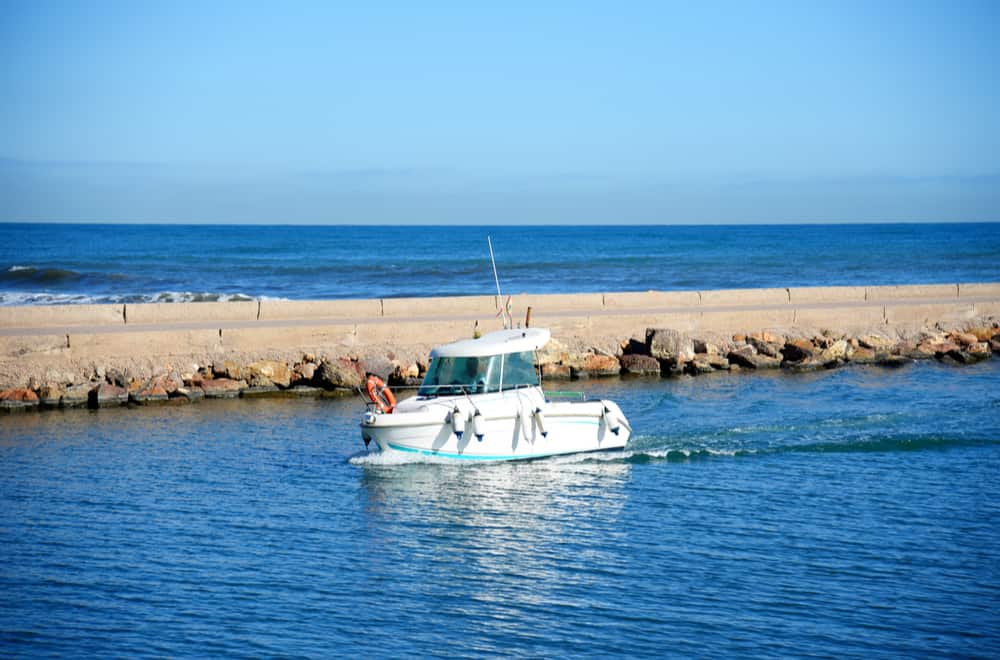
A skiff is a mini, under 20 feet (6 m) long boat suitable for shallow water and tight fishing spots. It is typically 300 to 900 pounds (135 – 410 kg) heavy and comes with a small light motor .
You can move this vessel made of light materials like aluminum or fiberglass with a long pole. It is also practical for towing, and you only need a car or crossover for such an activity.
Fishing boat
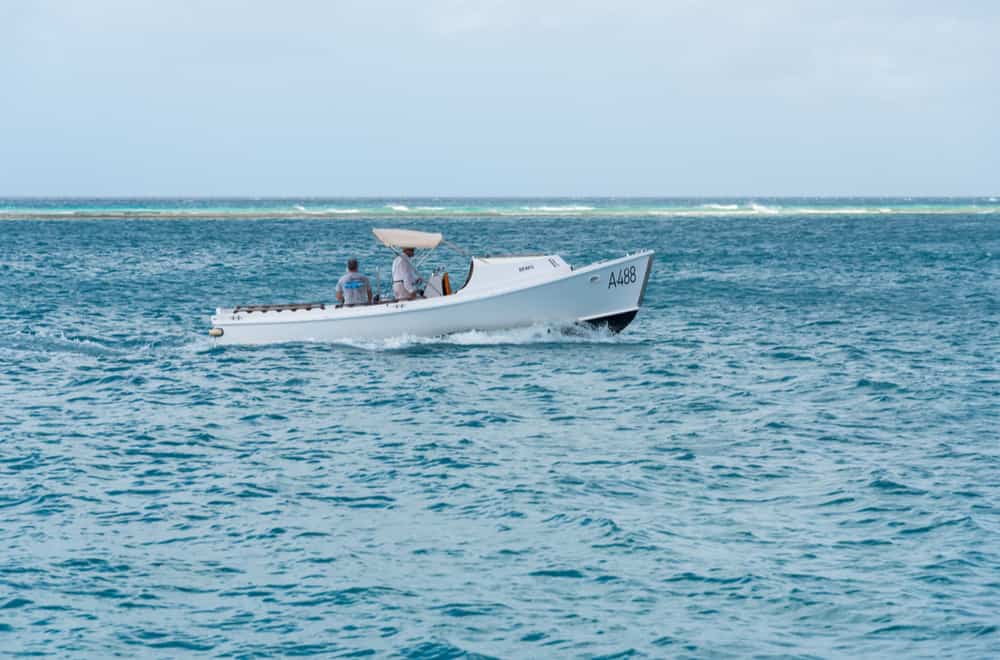
An average fishing boat can weigh 300 to 2,500 pounds (135 – 1,100 kg), depending on the material used for its making. Most people pick out one of the standard models weighing approximately 1,700 pounds (770 kg).
The excellent thing is that you can tow it effortlessly, but the type of vehicle you need directly depends on your vessel type and weight. You can tow smaller models with your car, crossover, or SUV, but you need a truck for towing heavier boats.
Aluminum fishing boat
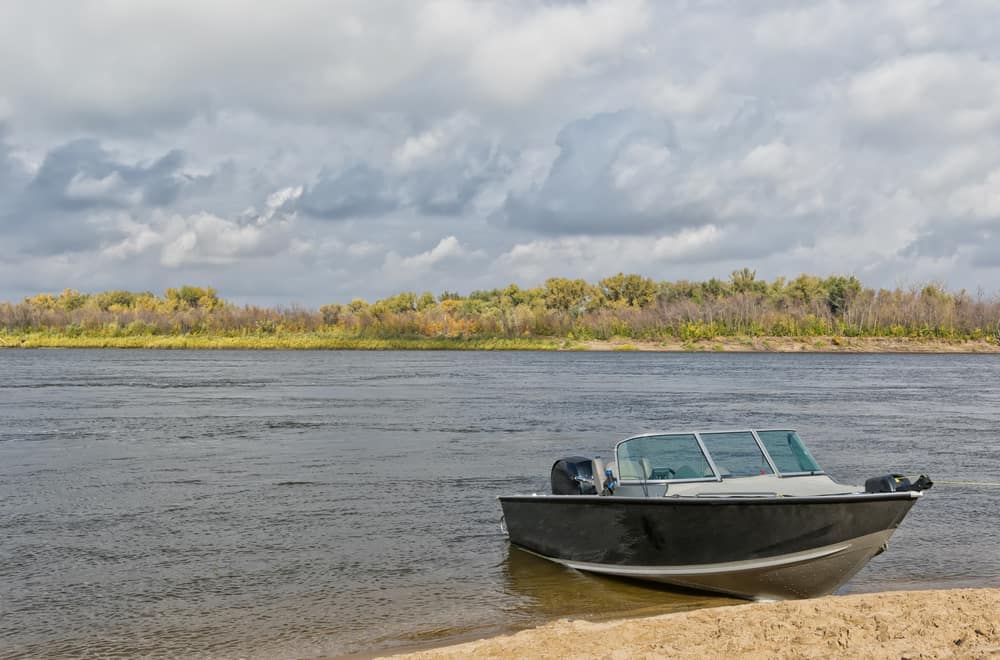
An aluminum fishing boat is 16 feet (4.9 m) long and 300 to 500 pounds (135 – 225kg) heavy on average. It comes with a flat or a deep V bottom and uses a small electric or outboard gas engine . All in all, its weight is almost always under 1,000 pounds (453.5 kg).
If you have a fishing boat with a small motor , that weight will be about 650 pounds (295 kg). A sizable engine increases that value to about 900 pounds (410 kg).
Fiberglass fishing boat
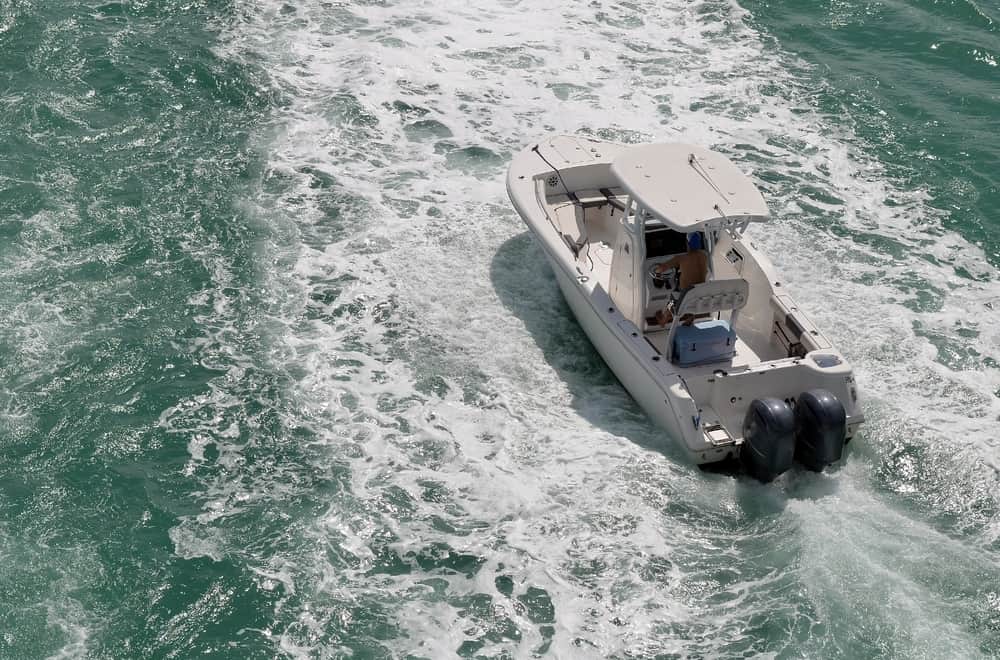
This durable, 16 to 20 feet (4.9 – 6 m) long fishing boat is typically 1,500 to 2,500 pounds (680 – 1,100 kg) heavy. Some sizable models can weigh 2,900 pounds (1,315 kg). You can expect it to reach at least 5,000 pounds (2,270 kg) with an engine and trailer.
Personal watercraft
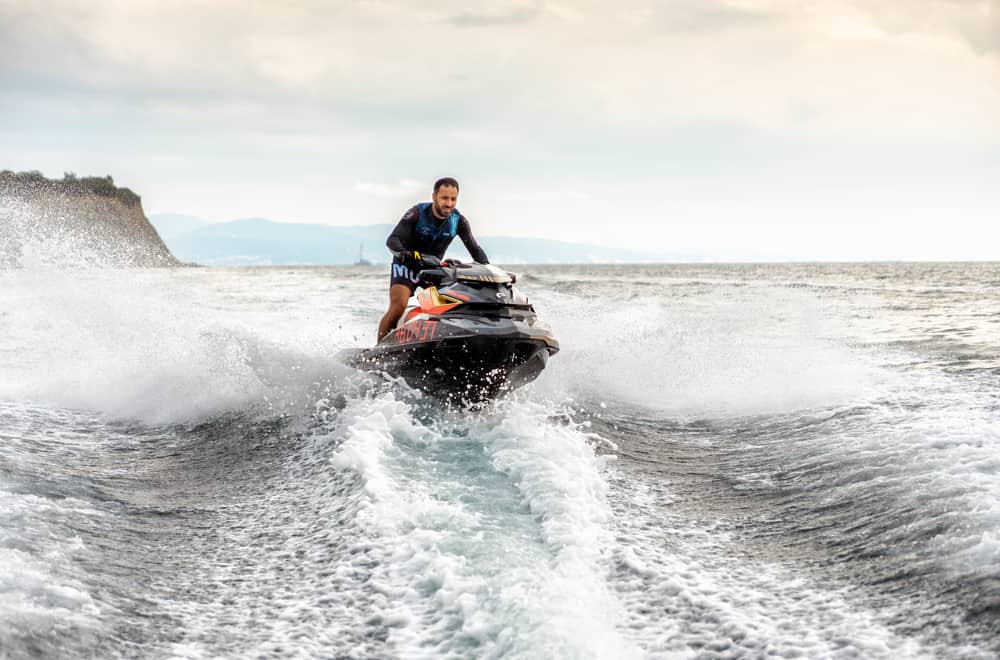
PWC (personal watercraft) is often known as Jet Ski and Wave Runner. It is technically not a boat, but people who enjoy fun water activities consider it a one-person boat. With a weight of only 800 to 850 pounds (363 – 385 kg), it is in a group of lightweight vessels you can carry with a car, SUV, van, or truck.
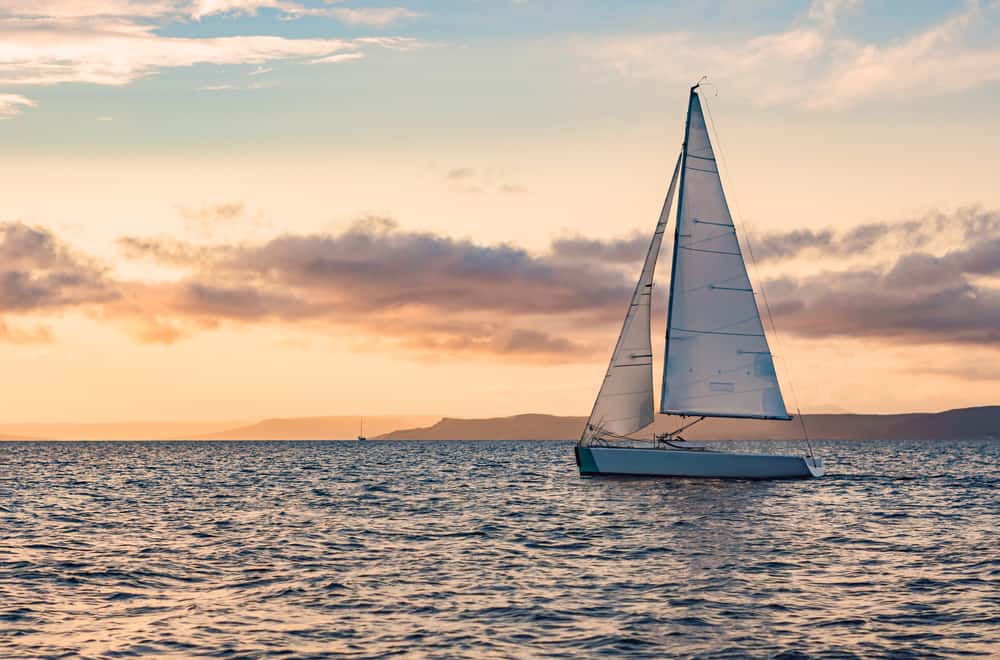
Sailboats are vessels you need to propel by sails. They come in wide weight ranges, and you can find models weighing 120 to 36,000 pounds (54.5 – 16,330 kg).
In other words, it can be tricky to transport if it is hard to tow it. You should have a car or crossover for smaller models, but even trucks can’t tow the most sizable ones weighing over 12,000 pounds (5,443 kg).
You can roughly divide sailboats into two groups, depending on their measures:
14 to 18 feet (4.3 – 5.5 m) long sailboats
So-called day sailboats without onboard overnight accommodation are typically 14 to 18 feet (4 – 5.5 m) long. Most models weigh 400 to 800 pounds (180 – 360 kg) in total. It primarily depends on the material they are made of, including aluminum , fiberglass, or wood .
You can pick out this model to sail on calm waters like lakes and bays. A car and crossover are typically strong enough to tow this boat even long distances.
20 to 30 feet (6 – 9 m) long sailboats
You can use 20 to 30 feet (6 – 9 m) long sailboat for family cruising, but some models include cabins for sleeping. Vessels over that length are considered yachts. The expected weight is 4,000 to 8,800 pounds (1,800 – 4,000 kg), and you can have difficulties carrying your boat even with a truck.
Bowrider boat
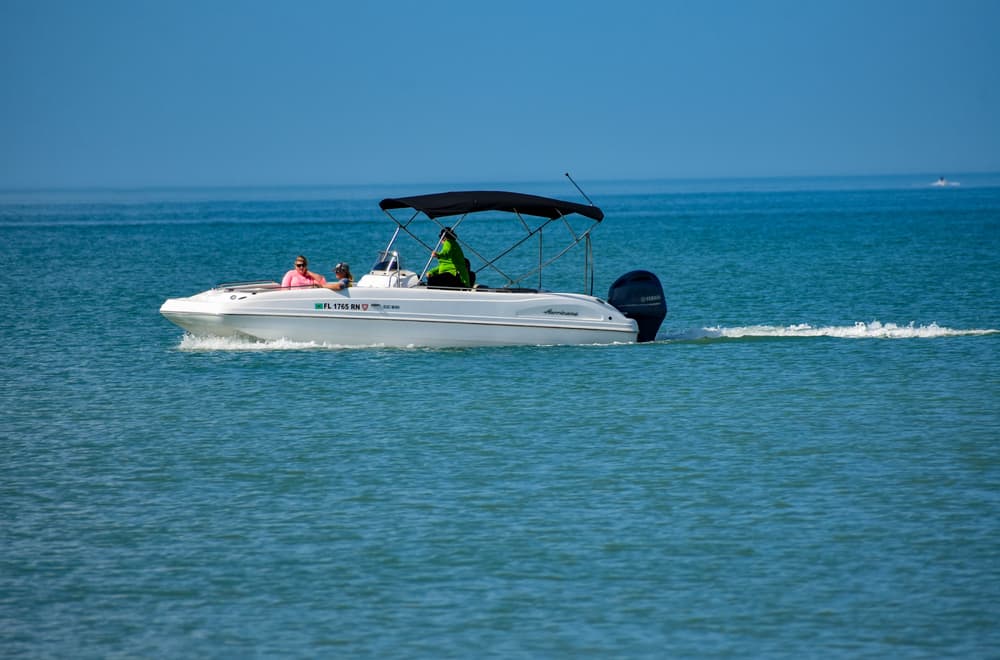
This boat type made of fiberglass is a desirable option for comfortable short cruises. You can find 16 feet to 25 feet (4.9 – 7.6 m) models with an inboard or outboard engine . Their total weight is 3,000 to 3,500 pounds (1,350 – 1,600 kg) on average, so you need an SUV or truck to tow it.
Pontoon boat
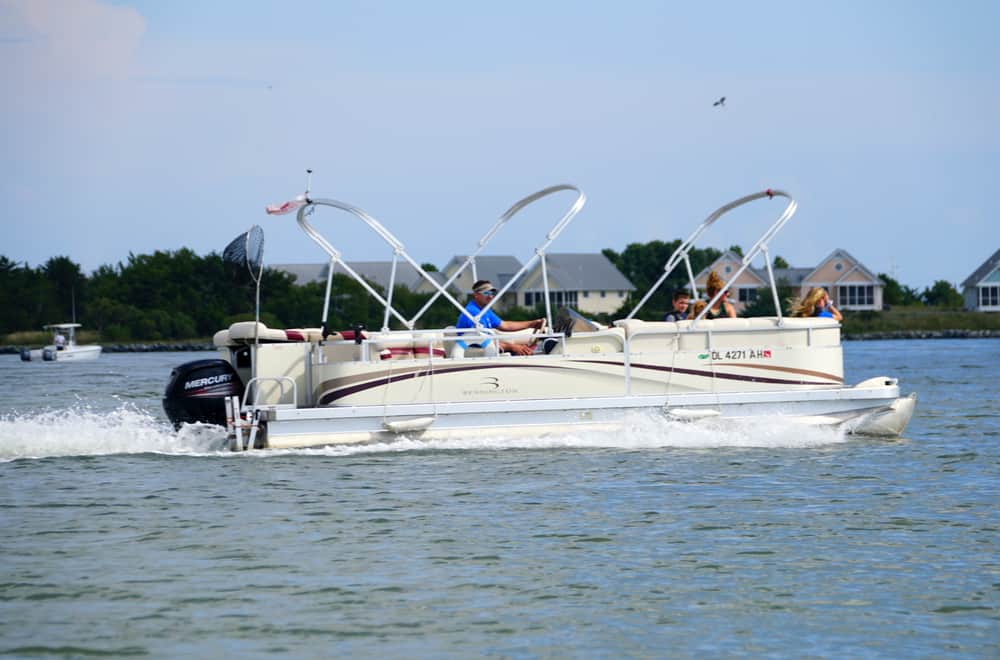
Most pontoon boats with two or even three hulls weigh 3,000 to 5,000 pounds (1,350 – 2,300 kg). As you can guess, only an SUV or truck can tow such a sizable vessel.
Be careful if you have a small SUV since some models can’t deal with such a weight. Pus, always check this boat’s width to prevent possible problems with towing it along the road.
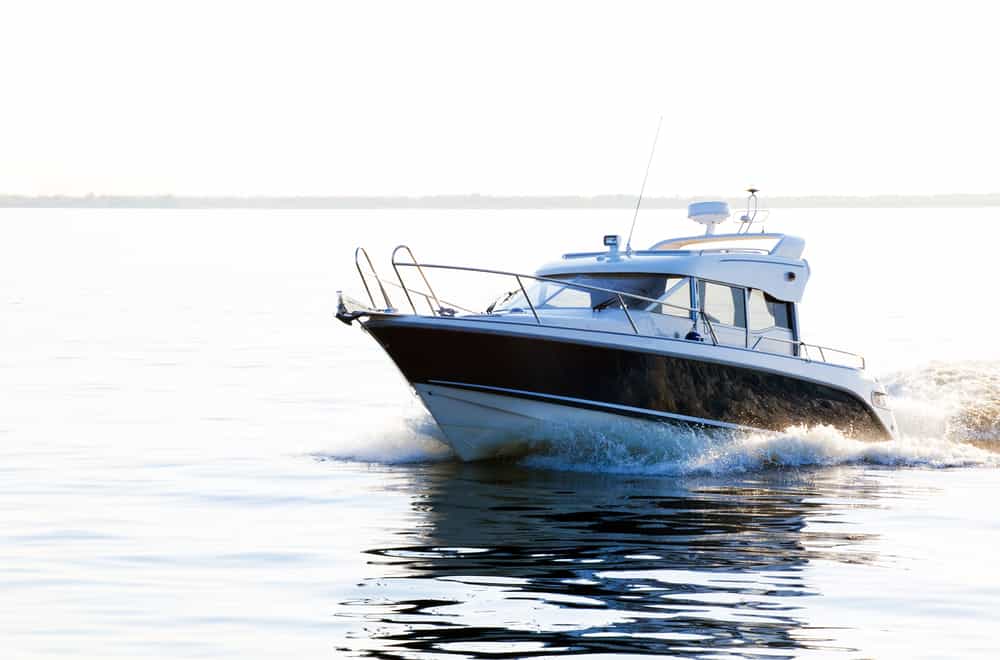
Thanks to enough deck space, a deck boat is an excellent 20 to 30 feet (6 – 9 m) long option for family day cruises. They are similar to pontoon boats but with only one hull. Since most models are 3,000 to 5,000 pounds (1,350 – 2,300 kg) heavy, you will need an SUV or truck for transportation.
Cuddy cabin
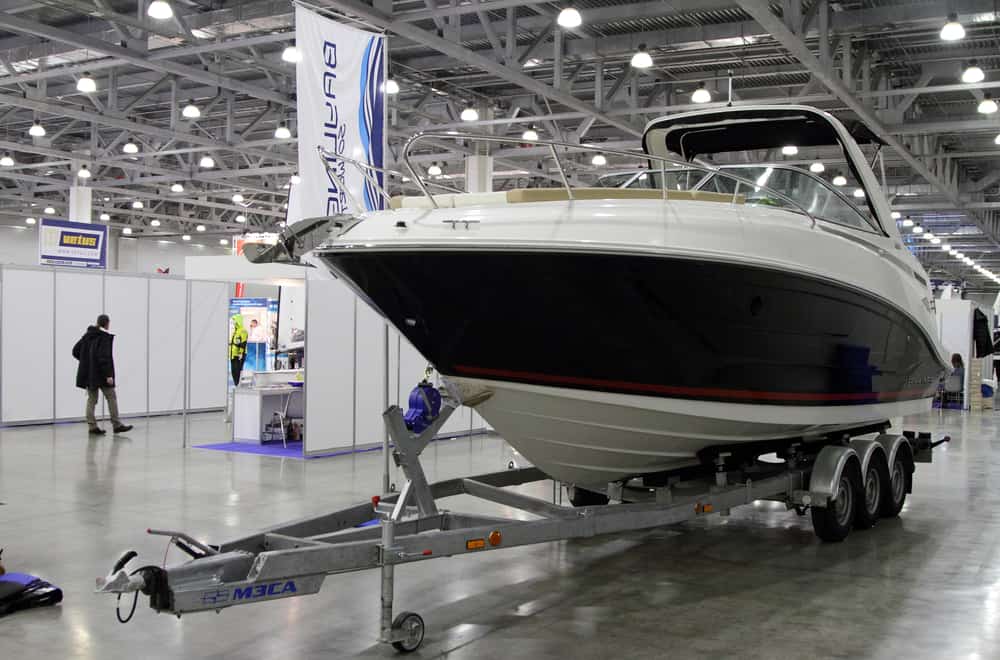
With a small sleeping area and short-term cruising capability, this boat combines a bowrider boat and cabin cruiser. You can find it in the 20 to 30 feet (6 – 9 m) length range.
Its weight is 3,000 to 5,000 pounds (1,350 – 2,300 kg) on average. Considering these measures, you can see that only a sizable SUV and truck are options for towing.
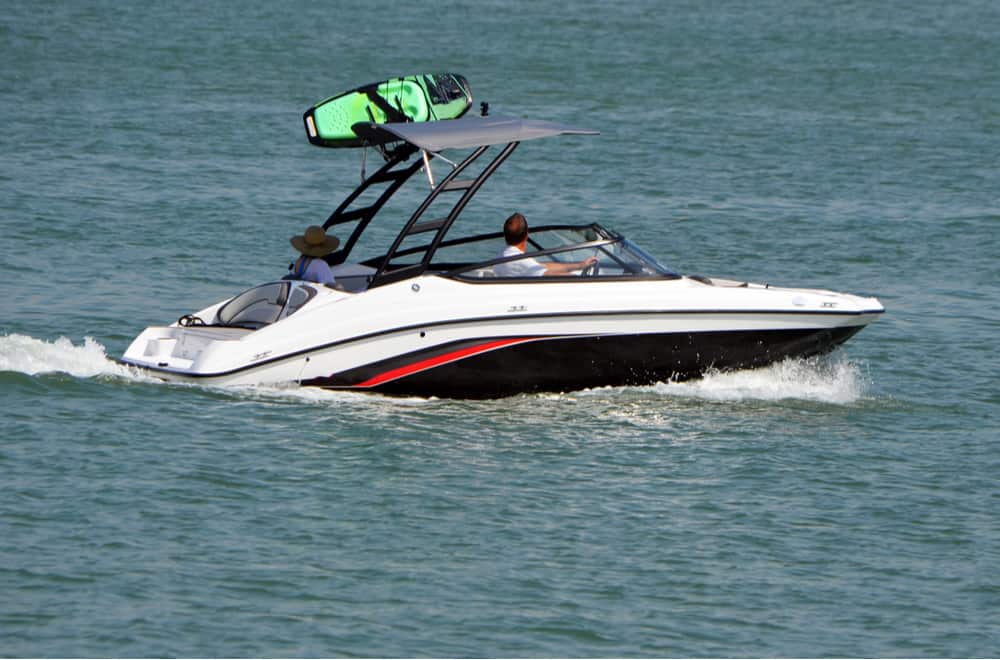
This vessel is an excellent option for watersport enthusiasts and surfers, thanks to its ability to make waves behind the hull. Most models are 20 feet (6 m) long with 3,000 to 5,000 pounds (1,350 – 2,300 kg) of dry weight.
Since you need to add an engine and tailor weight to this number, you will need an SUV or truck for safe transportation.
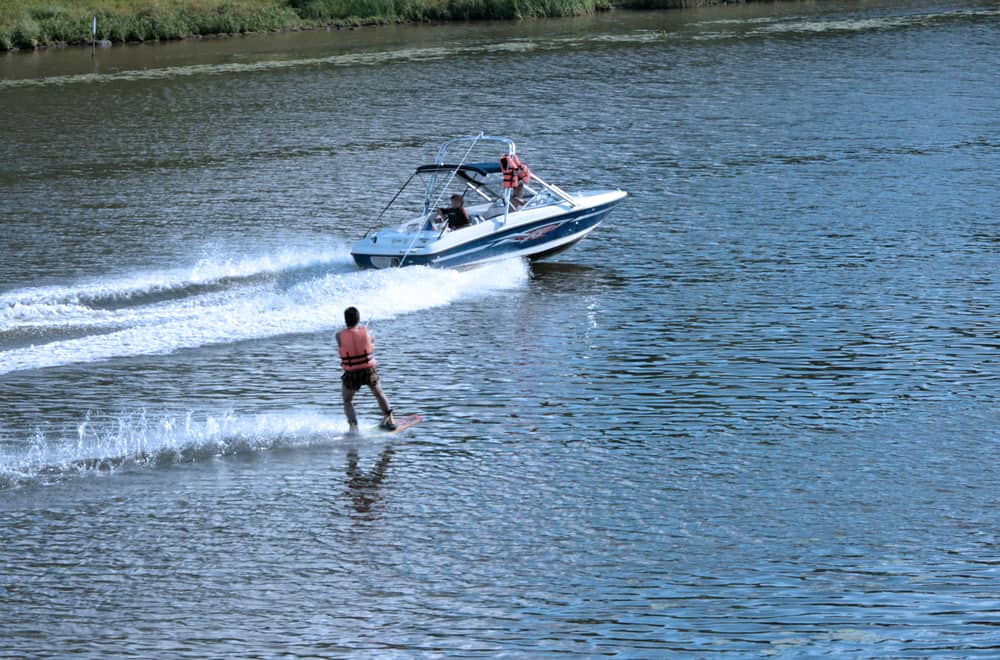
An average ski boat will weigh 3,500 pounds (1,600 kg), but you can find them in a weight range of 2,000 to 6,000 pounds (910 – 2,700 kg).
This vessel model has become highly popular in recent years because of activities you can use it for, like water skiing and wakeboarding . The only way to effortlessly tow this boat is to have a middle-sized SUV or truck.
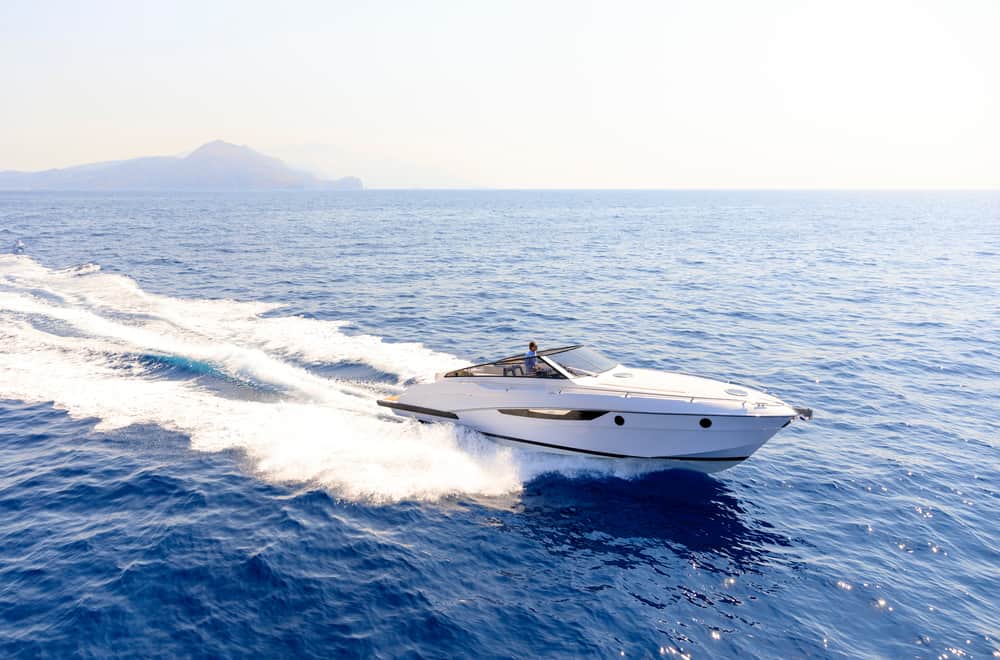
The so-called cigarette boat has a slim and stylish outer design that can vary depending on the model and make. Its purpose is to be fast and provide the thrill of the ride.
This sleek and stylish boat typically comes with an average weight of 8,000 pounds (3,600 kg). However, you can find drastic weight differences because of robust engines.
Even though this vessel is not challenging to tow, you need to have a sizable SUV or truck for this purpose.
Cabin cruiser boat
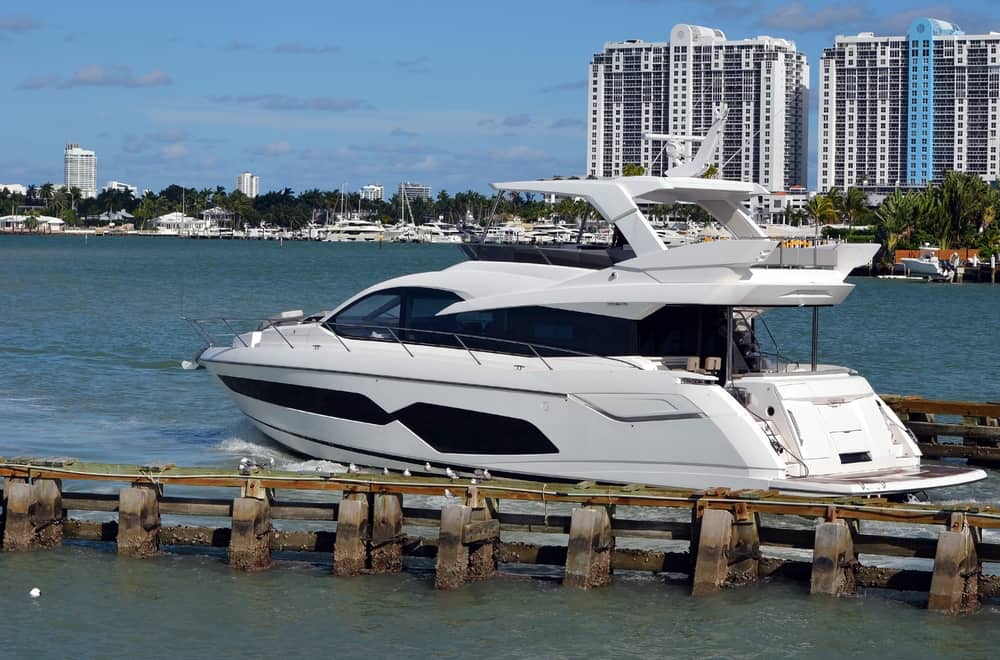
A cabin cruiser is actually a small, 25 to 45 feet (7.6 – 13.7 m) long yacht weighing 9,000 to 16,000 pounds (4,000 – 7,250 kg) on average. It is like a mini portable house you can use on the water with enough inside space for sleeping when necessary.
Keep in mind that the sleeping accommodation size will directly affect its weight. You can consider buying this vessel only if you have an appropriate truck for towing.
Before buying a boat , you need to determine its weight with complete equipment and trailer to determine the vehicle type you need to tow it. If you pair the wrong car with a too heavy boat, you will probably cause irreparable damage and lose money instead of enjoying sailing.
The only option you can make is to think of purchasing an adequate vehicle before considering a heavier boat type.
The boat weight is a vital deciding factor you should keep in your mind before purchasing one. You should check both dry and wet weight to ensure your safety while on the open waters. Plus, this measurement will help you pick out the proper trailer and match it with the vehicle you own.
Related posts:
- How to Obtain a Motor Boat License? (Unlimited Guides)
- 11 Right of Way Rules for Boating
- What Size Battery Do I Need for My Boat? (Chart)
- Boat Trailer Tires: Everything You Need To Know
Leave a Comment Cancel reply
Save my name, email, and website in this browser for the next time I comment.

How Much Does a Boat Weigh? Understanding Vessel Weight Averages

Here’s a basic breakdown of average weights by boat type:
- Aluminum Fishing Boats: Typically range from 300 – 500 pounds
- Bow Riders: Usually weigh around 3,000 – 3,500 pounds
- Cabin Cruisers: Often weigh between 12,000 – 16,000 pounds
For larger vessels, the weights can significantly increase. For instance, medium-sized boats ranging from 28-35 feet can weigh between 5,800-13,500 pounds . Even more substantial are large boats within the 36-45 feet category , boasting weights anywhere from 15,500-29,000 pounds .
Each type of boat serves a different purpose, and understanding their weight is essential for handling , transport , and storage . Boat owners and potential buyers must recognize how these weights may impact the boat’s performance, the capacity of their vehicle for trailering, and ultimately, the safety of their journeys on the water.
Types of Boats and Average Weights
When considering the purchase of a boat or preparing to transport one, knowing the average weight is essential. This weight impacts the necessary trailer , storage options, and potential restrictions on use.
Dinghies and Skiffs
Dinghies and skiffs are small, lightweight boats often used for short-distance travel and fishing in calm waters. Typically, skiffs vary in weight from 300 to 1,000 pounds , depending on materials and length.
Fishing Boats
Fishing boats come in a variety of shapes and sizes, each designed for the specific needs of anglers. Small aluminum fishing boats can be as light as 400 pounds , while larger, more equipped models, like a 20-foot center console boat, might weigh approximately 1,600 to 2,500 pounds . Average weights for different types of fishing boats can guide buyers and owners in logistical planning.
The weight of sailboats can significantly vary based upon size, design, and the materials used in construction. A small day sailer might weigh around 700 pounds , while a large keelboat can exceed 10,000 pounds . Sailors must consider this when assessing mooring requirements and dry dock storage.
Pontoon Boats
Pontoon boats are known for their flat, stable platforms and lightweight construction. An average 22-foot pontoon boat may weigh about 2,200 pounds without the added weight of the engine, fuel, and gear. Pontoons are popular for leisurely trips on calm lakes and rivers.
Speedboats, designed for higher speeds and agility on the water, have a broader weight range. A typical 20-foot speedboat weighs between 2,500 to 3,500 pounds , influenced by the hull material and additional features for performance.
Cabin Cruisers
Cabin cruisers provide comfort and amenities for extended stays on the water and are consequently heavier. On average, a 14-foot cabin cruiser will typically weigh in the ballpark of 14,000 pounds , with larger models increasingly heavier. Detailed statistics on cabin cruiser weights offer insight into the robust infrastructure required for docking and maintenance.
Factors Influencing Boat Weight

Several variables contribute to the overall weight of boats, each component playing a pivotal role in determining the final measurement. Understanding these factors can assist in anticipating the weight range of a vessel.
Material Construction
The materials used to build a boat significantly affect its weight. For instance, boats constructed from fiberglass tend to be lighter than those made of wood. On the other hand, aluminum boats offer a balance between durability and weight, often being lighter than wood but heavier than fiberglass. Specific data on boat materials and their weights help illustrate these distinctions.
Boat Size and Dimensions
The overall length and width of a boat are directly proportional to its weight. Larger boats have more mass simply due to their size. A boat that falls within a 17-22 feet range might weigh around 1,600-3,200 pounds , whereas boats that are 23-27 feet long can weigh between 3,600-4,800 pounds . Dimensions play a crucial role in assessing weight, per details found on a boating data chart .
Engines and Equipment
The quantity and size of the engines , along with additional equipment such as electronics and fishing gear, also add to a boat’s weight. More powerful engines and extensive equipment result in a heavier vessel. A detailed weight calculator can be leveraged to evaluate the total weight considering such variables, as demonstrated by this Boat Weight Calculator .
Fuel Capacity
The capacity of the fuel tank influences a boat’s weight, as the weight of the fuel must be considered when calculating the total mass. Full fuel tanks can significantly increase the overall weight, which is essential for calculating transport and performance characteristics. Details on the impact of fuel capacity on weight are discussed in J.D. Power’s boating guide .
Boat Weight and Transportation
When considering transportation for boats, the weight of the boat and its associated gear is a critical factor in choosing the right trailer and tow vehicle.
Trailer Weight Considerations
The weight of the boat is often specified as dry weight , which does not include fuel, gear, or other items that might be on board during transport. A boat’s dry weight plus the weight of its engine, fuel, and equipment is referred to as the gross weight , and it’s important to know when selecting a trailer. For example, a skiff typically weighs between 300 to 900 pounds , which would necessitate a different trailer than a larger vessel such as a cabin cruiser.
The trailer itself also has a Gross Vehicle Weight Rating (GVWR) , which is the maximum weight the trailer can safely carry. This includes the boat’s weight, the trailer’s weight, and any additional cargo. Here is a simplified example of boat and trailer weight considerations:
Towing Vehicle Requirements
The tow vehicle must be capable of handling the combined weight of the boat and the trailer. This is referred to as the towing capacity . The vehicle’s owner’s manual will list the towing capacity which must exceed the combined weight to ensure safe transportation. Trucks and SUVs often have higher towing capacities, with some trucks being able to handle more than 5,000 pounds easily, including the boat and the trailer weight.
When selecting a vehicle for towing, one must consider the following factors:
- Engine Size : Larger engines generally provide more towing power.
- Transmission : A vehicle with a transmission cooler is preferable for towing, as it helps prevent overheating.
- Braking System : A robust braking system is vital, as it needs to stop the additional weight safely.
- Suspension : The vehicle should have a capable suspension system to handle the load and maintain stability.
Weight Capacities of Boats
When discussing the weight capacities of boats, one needs to closely examine not only the manufacturer’s specifications but also the safety compliance ratings to ensure a secure and enjoyable boating experience.
Manufacturer Specifications
Boat manufacturers typically provide a boat’s weight capacity in their specifications. For instance, small boats might have a weight capacity of several hundred pounds while larger boats can hold weights of several thousand pounds. Boat Weight Capacity Calculator – GEGCalculators provides estimated weight capacities for various boat lengths, but stresses that these can vary due to design and construction differences.
Safety Compliance Ratings
Safety compliance ratings, such as those established by the U.S. Coast Guard, are essential for determining how much weight a boat can safely carry. These ratings incorporate an average weight per person to calculate the maximum number of passengers. As per BOATERexam.com® , many manufacturers use an average weight of 150 pounds per person for these calculations. However, if passengers are heavier than this average, the number of people on the boat may need to be reduced to stay within safe operational limits.
Measuring Boat Weight
Assessing a boat’s weight involves understanding the distinctions between dry weight and wet weight, as well as utilizing specific tools to determine the mass accurately.
Dry Weight Vs. Wet Weight
Dry Weight refers to the boat’s mass without any consumables or gear. This includes only the hull and installed equipment such as the engine and built-in fixtures. It is the base weight of the boat when it’s not in use and is crucial for transportation and storage considerations.
- Fluids (e.g., fuel, oil, freshwater)
- Equipment and safety gear
- Personal belongings and provisions
Wet weight is most relevant for operational purposes, such as compliance with safety regulations and determining the boat’s performance and fuel efficiency.
Tools for Weighing Boats
To measure a boat’s weight, marine scales or crane scales are typically employed.
- Marine Scales : These are specialized scales designed to accommodate a boat’s size and shape. They are often found at marinas and boatyards.
- Crane Scales : For larger vessels, crane scales may be used. These are attached to a crane that lifts the boat, measuring its weight through tension.
It is essential to consult the boat’s manufacturer or a professional weighmaster to ensure accurate measurements, particularly when the data will be used for legal or commercial purposes.
Frequently Asked Questions

Understanding the weight of different types of boats and the factors that contribute to it is essential for safe operation and transportation. This section addresses common queries related to boat weight.
What is the average weight range for fiberglass boats?
The average weight range for fiberglass boats can vary widely, but generally, a mid-sized fiberglass boat can weigh anywhere from 2,500 to 15,000 pounds.
How can you calculate the weight of a boat including its trailer?
To calculate the weight of a boat including its trailer, one must first determine the boat’s dry weight and then add the weight of the trailer, which is typically between 300 to 1,500 pounds. The weight of any additional gear or fuel should also be included in the calculation.
What are the typical weight considerations for towing a boat?
When towing a boat, weight considerations include the boat’s dry weight, the weight of the trailer, and the weight of gear, fuel, and any other items aboard. The towing vehicle’s maximum towing capacity must not be exceeded.
What’s the approximate weight of a small (12-16 foot) boat?
A small boat measuring between 12 to 16 feet can weigh between 100 to 1,200 pounds, depending on the design and materials used.
How does boat length impact the overall weight?
Boat length significantly impacts overall weight. Generally, as a boat’s length increases, so does its weight, due to larger hulls, bigger engines, and extra features or equipment.
Where can one find a reliable boat weight calculator?
A reliable boat weight calculator can help estimate the total weight of a boat including gear and fuel. One can find this tool on boating websites or by contacting manufacturers directly.
Leave a Comment Cancel reply
Save my name, email, and website in this browser for the next time I comment.
Keep in mind that we may receive commissions when you click our links and make purchases. However, this does not impact our reviews and comparisons. We try our best to keep things fair and balanced, in order to help you make the best choice for you.
As an Amazon Associate, I earn from qualifying purchases.
Vanquish Boats
500 Lewis Drive Carolina Beach, NC
+1 910-707-3599
© Vanquish Boats
Buying a new boat?
See our list of builders offering Seakeeper on their boats.
Have an existing boat?
Size does matter, which seakeeper is right for you.
No one knows more about how you boat than you! Enter your boat information and we will guide you through the options so you can decide which Seakeeper is right for you.
Select Boat Beam
2.45 Meters
2.60 Meters
2.75 Meters
2.90 Meters
3.05 Meters
3.20 Meters
3.35 Meters
3.50 Meters
3.65 Meters
Round to the nearest 0.5 foot
Select Boat Length
6.70 Meters
7.00 Meters
7.30 Meters
7.60 Meters
7.90 Meters
8.20 Meters
8.55 Meters
8.85 Meters
9.15 Meters
9.45 Meters
9.75 Meters
10.1 Meters
10.4 Meters
10.7 Meters
Round to the nearest foot
Results for your boat
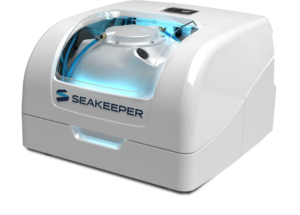
Seakeeper 1
(not including installation)
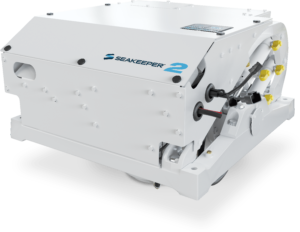
Seakeeper 2
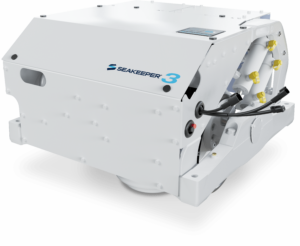
Seakeeper 3
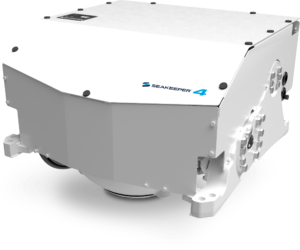
Seakeeper 4

Seakeeper 4.5

Seakeeper 6
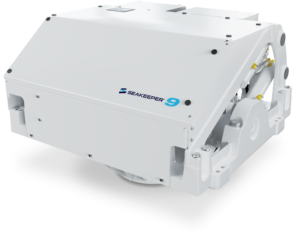
Seakeeper 9
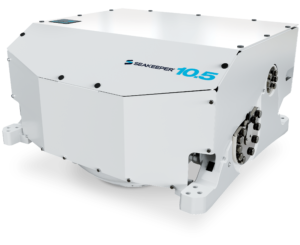
Seakeeper 10.5
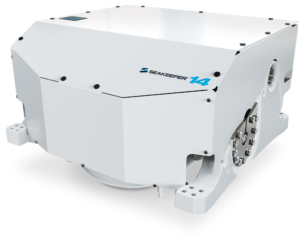
Seakeeper 14
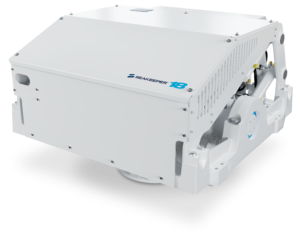
Seakeeper 18
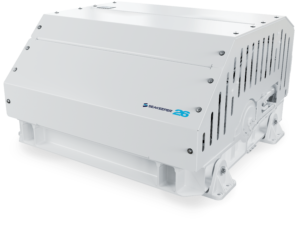
Seakeeper 26
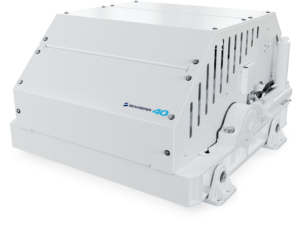
Seakeeper 40
Side-by-Side Comparison
Center Console Specs*
*Vessel specifications verified by inclined study. Natural roll period verified by sea trail results.
Sea Conditions
For gyroscopic stabilizers, angular momentum (measured in Newton-meter-seconds, or N-m-s) is the equivalent of horsepower for an engine and is the accepted measure of rating gyroscopic output. The angular momentum determines the total amount of torque available over time. Therefore, greater angular momentum indicates greater levels of roll reduction potential for gyroscopic stabilizers.
Breezy WSW winds with moderate choppy seas. Very small short period waves.
Wind: WSW 7 to 10kts
Avg Wave Height: SE 2ft at 5 secs
Roll Reduction
Moderate to strong SW winds with choppy seas. Small short period waves.
Wind: SSE 14.5kts
Avg Wave Height: SSW 2.4ft at 3 secs
Bluewater 35 Specs*
Wind: WSW 10 to 13kts
Wind: SW 15 to 20kts
Avg Wave Height: SSW 3-4ft at 4 secs
Don't see your boat? Contact Seakeeper for a customized sizing.
Notice to consumer: Actual performance may vary depending on boat specifictaions and design as well as variations in sea conditions. Sea conditions are extremely difficult to quantify due to the random nature of wind generated waves and swell. No guarantee is expressed or implied.
Follow Seakeeper for Updates
Get on the list to receive updates about new Seakeeper products, exclusive sales, events, and more.
Privacy Overview
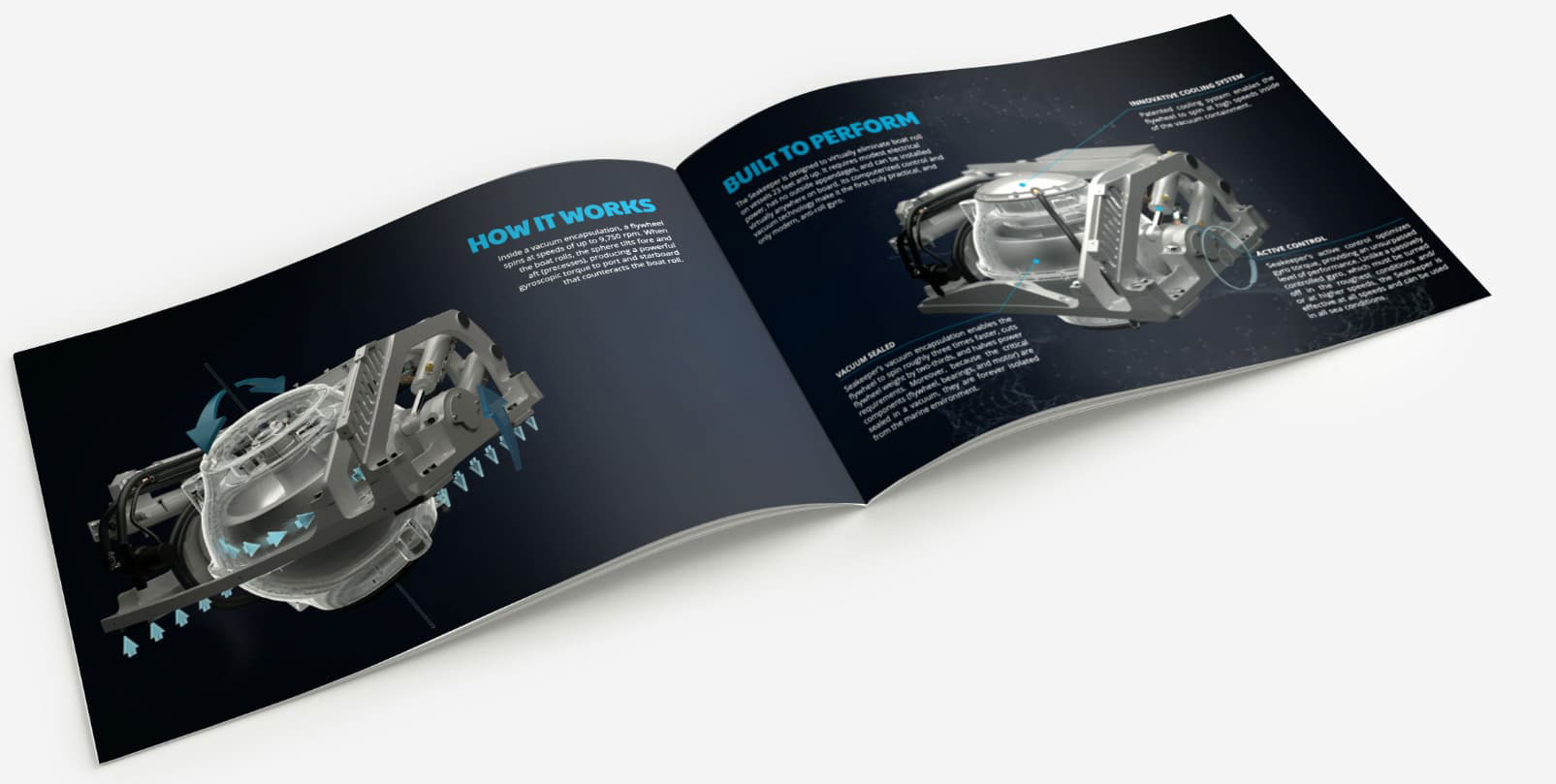
Seakeeper Brochure

- Forums New posts Unanswered threads Register Top Posts Email
- What's new New posts New Posts (legacy) Latest activity New media
- Media New media New comments
- Boat Info Downloads Weekly Quiz Topic FAQ 10000boatnames.com
- Classifieds Sell Your Boat Used Gear for Sale
- Parts General Marine Parts Hunter Beneteau Catalina MacGregor Oday
- Help Terms of Use Monday Mail Subscribe Monday Mail Unsubscribe
How much does a sail weigh?
- Thread starter bilsheryl
- Start date Aug 25, 2012
- Forums for All Owners
- Ask All Sailors
Does any one know how much a sail weigh? I know different sizes will weigh differently. Just wondering.
That's like asking, "How much does an animal weigh?" You gotta be waaay more specific about size, material type etc., otherwise it's impossible to answer.
I had a main and a jib mailed to me by a fellow member here and the package was listed as weighing 20lbs which included the packaging (cardboard box). That was for a stock H23 sail and jib, ymmv. Cheers, Brad
How about? For a sailboat between 15-22 ft, and I am thinking along the lines of a 110 jib. The drifter made with poly tarp didn't cross the foredeck so I am curious.
So a main and jib weighed 22 lbs, 11 lbs apiece more or less,probably less. Does anyone use a drifter? And is it made out of Dacron?
I have a drifter that is made from ripstop nylon.
Ross, Thank you for responding. How long is the foot of your drifter?
bilsheryl said: So a main and jib weighed 22 lbs, 11 lbs apiece more or less,probably less. Does anyone use a drifter? And is it made out of Dacron? Click to expand
Thank you sir, very much. All I need to do is learn to sew! I figured out that to make a large genoa I need lighter sail material. I love challenges! Do where can I buy cheap nylon material? Just jokin!
bilsheryl said: Thank you sir, very much. All I need to do is learn to sew! I figured out that to make a large genoa I need lighter sail material. I love challenges! Do where can I buy cheap nylon material? Just jokin! Click to expand
This is a book that you should own and read before you buy the first yard of cloth. http://www.sailrite.com/The-Sailmakers-Apprentice-Book
It doesn't matter, it is for a heavy 30 foot boat.
It's more for seeing the difference between a poly tarp and "never knew this" nylon. Please forgive me for my lack of knowledge on sails, remember momma won't let me spend money on a "stupid" sailboat. I will do whatever it takes to sail!!! Going out on Sunday,please don't tell momma!?!?!?!?
And for the info on books, thank you.
"the admiral" that's what I thought the reference were referring to. Because on Saturday she caught me looking at yellow non rip nylon, showing the lady behind counter a drawing of a sail! I very quickly snap to attention, and lied through my teeth. I think she believed me? Not!
Scott T-Bird
I agree that it may be condescending to one's wife if one always references her as "the Admiral". I can understand the sentiment, but I tend to wince when I see that. My wife has a name and her name is Sue. If I don't respect her, I don't deserve her then, either. Keep in mind, I'm not critisizing, as I assume all pet names are based on affection ... but I try not to overdue it.
Doc_holiday
I'm not sure using "the Admiral" is at all disrespectful. I suppose it's all in how you mean it when you say it. I certainly don't mean anything negative when I say it. My shirt and hat say skipper, hers say Admiral and has 4 stars on it. She kind of likes the title even though it's all in fun. She's only referred to as the Admiral when it comes to the boat. No negative connotation meant, none taken.
Everyone who reads this site regularly knows that I sail with a lady named Nancy. She is my wife, my best friend, and my lover. We are absolute partners. No bosses, no subordinates, no orders, lots of discussions.
- This site uses cookies to help personalise content, tailor your experience and to keep you logged in if you register. By continuing to use this site, you are consenting to our use of cookies. Accept Learn more…

IMAGES
VIDEO
COMMENTS
Sailboat lengths can range between 8 feet to 472 feet. The 472-foot sailboat also carries three masts that tower at over 91 feet each. This can definitely add more weight than the 8-foot vessel. Listed below are 6 examples of sailboats and their weights and lengths: Catalina 16. LOA: 16 ft. 4 in.
Boats 23-27 feet weigh around 3,600-4,800 pounds. Medium-sized boats 28-35 feet weigh around 5,800-13,500 pounds. And large boats 36-45 feet weigh around 15,500-29,000 pounds. Boat weight is referring to the wet weight of a boat (dry weight of boat plus engines, fuel, and gear)
The total estimated upfront costs of buying a 50-foot yacht range from $458,000 to $692,000 and include the initial purchase price and other fees. There are also hidden costs that total $70,000-$300,000+ per year. For ongoing costs, the total estimated annual costs are $35,000-$85,000 per year. Although costly, with proper budgeting ...
50 ft sailing yachts from Kraken Yachts. Find out more about the Kraken 50, including the specification, internal layouts and much more. ... Ballast Weight 14,330 lbs. Ballast Ratio 34.2%. Sail Area 1444.52 sq.ft. Sail Area Displacement Ratio 19.2. Engine Power 80 HP. Fuel Tanks (3 tanks) 223 us gal.
How Much Does An O'Day 25 Weigh? Despite being only a few feet shorter than the Catalina 30, the O'Day 25 is a much different boat. This popular day cruiser has a displacement of only 4,007 pounds, which is less than half of the Catalina 30. The O'Day 25 falls into the medium weight category with a D/L ratio of only 193.16.
The minimum planing speed of 16 knots, with a little trim-tab assist, ensures a versatile and practical speed envelope for cruising, and from here on up to 28 knots the 50 returns pretty good fuel efficiency and useful range. A top speed of over 32 knots with a full load of water and a one-third load of fuel exceeded Azimut's initial ...
June 3, 2021. Boat owners will often move into the 50 foot yacht range when looking to do more than simple day boating excursions. While still typically owner-operated, a 50 foot yacht provides increased flexibility with regards to living spaces and can offer a wide array of amenities that suit your tastes and needs while on the water.
While still typically owner-operated, a 50 foot yacht provides increased flexibility with regards to living spaces and can offer a wide array of amenities that suite your tastes and needs while on the water. When moving from a vessel in the 40 foot range up to the 50 foot range, owners can begin expecting three stateroom layouts.
In short, an average sailboat of15-20 feet weighs around 1047 pounds. Moreover, the average weight of a 21-25 feet sailboat is around 2826lbs and the average weight of a 27-32 feet sailboats is 5410 lbs. Finally, the average weight of a 35-40ft sailboat is approximately 18,918 lbs. Sailboat Variations Sailboats.
Live out your sailing dreams aboard the Leopard 50. This catamaran is everything you envisioned, plus so much more. With a never-before-seen lounging flybridge of this size, the Leopard 50 incorporates the best attributes from its predecessor and 2012 Boat of the Year, the Leopard 48. Now, with even more living space and options, your journey ahead is boundless.
How Much Do Boats Weight by Type. Dinghies and Small Sailboats (100-1,000 lbs, 8-20 feet) ... 20-50+ feet) Sailboats can vary greatly in weight, depending on their size, hull material, and rigging. Smaller sailboats weighing 4,000-8,000 lbs can be towed with a full-size truck, while larger, heavier sailboats may require specialized transport. ...
Here are some general boat weights to consider before we get into the details: Type of Boat. Average Weight. Aluminum Fishing Boats. 300 - 500 pounds. Bow Rider. 3,000 - 3,500 pounds. Cabin Cruiser. 12,000 - 16,000 pounds.
48-50ft Catamaran Models Comparisons. We compare the specifications, dimensions, sail area, and pricing on the most popular 48-50ft catamarans in 2020. The Lagoon 50, Bali 4.8, FP Saba 50, and Leopard 50 are within a similar price range and dimensions, but there are major differences. Let's compare apples to apples to see how the match up.
We provide firm statistics to get a realistic idea of how much you can expect sailing catamarans and trimarans to weigh for a given length and a given construction type.Weights of 109 multihulls are plotted to make the comparison. The data is useful for making cost and performance predictions for new multihull yacht projects.
Boat Weight Calculator. This calculator will help you estimate the total weight of your boat by considering various factors such as dry weight, fuel and water capacity, holding tanks, and more. Please fill in all the required fields and select your preferred units. Unit System: Dry Weight: Fuel Capacity: Water Capacity: Holding Tanks/Bait Wells ...
8,700 lbs. Trucks. *PWCs. 850 lbs. Cars, Vans, Trucks and SUVs. Keep in mind that these average weights are the dry weight of these boat types. The weight of fuel the fuel, trailer, and other accessories can add up to 2,000 lbs to these average weights which can highly impact their ability to be towed.
14 to 18 feet (4.3 - 5.5 m) long sailboats. So-called day sailboats without onboard overnight accommodation are typically 14 to 18 feet (4 - 5.5 m) long. Most models weigh 400 to 800 pounds (180 - 360 kg) in total. It primarily depends on the material they are made of, including aluminum, fiberglass, or wood.
Here's a basic breakdown of average weights by boat type: Aluminum Fishing Boats: Typically range from 300 - 500 pounds. Bow Riders: Usually weigh around 3,000 - 3,500 pounds. Cabin Cruisers: Often weigh between 12,000 - 16,000 pounds. For larger vessels, the weights can significantly increase.
The F50 is a one-design foiling catamaran used in the SailGP race series. The name is an abbreviation of "Foiling" and "a hull length of 50 feet".The F50s are adapted from the AC50s used in the America's Cup, with modifications including new control systems and modular wingsails. The F50s are one of the fastest racing classes in history, with a predicted top speed of 52.2 knots (96.6 km/h, 60 ...
They can be manufactured from wood, aluminum, or fiberglass, generally based on your preferences. Without a motor, fuel tank, water tank, galley, or berths, there's not much weight outside the hull and the mast. Depending on a particular day sailboat, you are looking at a total weight between 400 and 800 pounds.
Boat Size: ~ 50' - 60' Boat Weight: Up to ~ 30 tons; $108,600; not including installation; Seakeeper 10.5. Boat Size: ~ 50' - 62' Boat Weight: Up to ~36 tons; $124,900; ... 28 ft Beam Overall 9.42 ft Displacement 12,529 lbs GM 2.23ft Natural Roll Period 2.56 secs *Vessel specifications verified by inclined study. Natural roll period verified by ...
How Much Does a 50 Foot Yacht Weigh . A 50 foot yacht typically weighs between 25 and 30 tonnes. This weight can vary depending on the materials used in construction and the type of engine fitted. Heavier yachts will have a shallower draft, meaning they sit higher in the water, while lighter yachts will have a deeper draft. ...
You really need to do a little more research on how sails are made. Sail cloth weight is expressed in ounces/square yard. For a boat your size 3.5 oz would be a typical cloth weight. A drifter would be less than 1 oz. A drifter is normally made out of nylon. Thank you sir, very much.